 Leading Blog | Posts by Category |
 Leading Blog | Posts by Category |
12.05.22

“In Search of Excellence” Revisited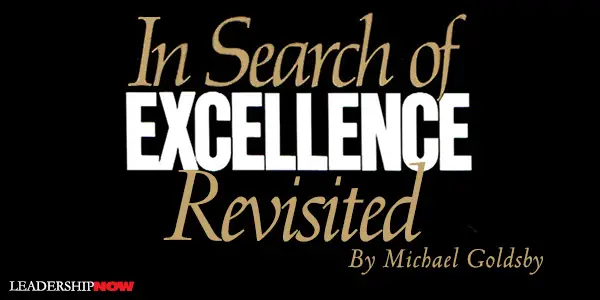
IN 1982, Tom Peters and Bob Waterman released In Search of Excellence: Lessons from America’s Best-Run Companies. The book was a huge business bestseller and served as a guide for managers for many years to come. It became required reading in business school classes. Yet, 40 years later, few now speak of the book. Perhaps it’s time for In Search of Excellence to find a new audience. When the book project started in 1978, the U.S. was in the midst of an economic quagmire. Inflation was in double digits while productivity and personal income were stagnant — an economic condition that became known as stagflation. Interest rates were through the roof. Interest rates on real estate loans had climbed to 20 percent and higher. The country was suffering an existential crisis, as well, amidst an OPEC oil embargo coinciding with Vietnam War and Watergate fatigue. Feel familiar? September 11th, the Iraq and Afghanistan wars, the Great Recession, the COVID pandemic, and polarized politics have created our own existential worries. Yet, Peters and Waterman pointed out that there were bright spots in the economy. In spite of the times, some companies were pursuing excellence in the execution of their missions. They believed if the characteristics of excellent companies could be identified and shared with corporate America, more organizations could perform better and lift the country out of its doldrums. Consider the timelessness of these key qualities: Eight Characteristics of Excellent Companies Like Jim Collins accomplished in Good to Great: Why Some Companies Make the Leap…And Others Don’t, Peters and Waterman developed a methodology for their study. Structure, strategy, people, management style, systems and procedures, guiding concepts and shared values, and corporate strengths and skills, along with financial performance, served as criteria for selecting excellent companies. Forty-three companies made the cut, with eight common characteristics identified among them:
The eight characteristics of excellent companies are well-known today, even if most aren’t aware of their source. But knowledge and application are two different animals. How many companies today are actually excellent? How many companies exhibit these eight characteristics? And is a new study needed to identify today’s excellent companies to serve as beacons to lift the country out of its malaise? Perhaps not. Buried within the text, Peters and Waterman offer the bottom line of how to identify excellence in companies. It’s one we use every day, consciously or not, whenever we buy something. At the best companies, “The love of the product and customer was palpable.” Love the Customer Love. It’s a strong word, eliciting romance and passion. But it can be adapted in a business context to reflect values of caring, kindness, consideration, respect, and honesty. Love can also be understood by placing it on the end of a continuum with its opposite: greed. We recognize a company’s greediness when it misleads, avoids making things right with its customers, ignores the well-being of its employees, layers bureaucracy between executives and everyone else to avoid accountability, shirks quality, and hits the customer with sneaky profit practices like hidden fees and up charges. Love and greed. You know them when you see them. For example, each time my local Culligan service delivery man comes with salt for my water unit, he tries to leave an unneeded extra bag in my garage. He tells me it’s to cut down on the number of trips to my house and save gas. He never gives me a straight answer on why he just doesn’t put the required amount in the unit and leave it at that. I now have six extra bags that have accumulated in my garage from the times I haven’t been able to stop this practice in person. The corporate office hasn’t solved the problem for me either. Whether it’s an accounting trick to boost sales per stop or a fuel savings for the driver, one thing is clear: Culligan is making a decision that’s good for them but not for the customer. That’s what greed, and not love for the customer, looks like. Harkening to the Golden Rule, companies should treat customers as they would like to be treated. Fred Reichheld, the creator of the Net Promoter Score, believes that love and greed are the foundations of two different types of capitalism: customer capitalism and financial capitalism. Customer capitalists abide by the Golden Rule with customers, whereas financial capitalists make decisions with the bottom line as their only guide. However, treating the customer with love is the best way to boost the bottom line in the long run. Financial capitalism, on the other hand, is concerned with short-term results without regard for long-term consequences. Capitalism is under scrutiny today as to whether it’s the right system for the country to operate under. Might simply loving the customer help companies make a better case for what capitalism can provide? Might loving the customer help companies play a role in boosting the morale of the country? Excellence is Discovered in the Details You can also identify a company pursuing excellence and one that loves the customer by how much it pays attention to the details in its products and services. Consider a movie theater. Is the condiment area stocked with supplies? Are the seats and aisles cleaned well between shows? Are the restrooms maintained well? These little touches add to a special environment for how we experience a movie. If the theater looks like it’s given the care of a messy college dorm room, we’re better off waiting for the movie to come to our big-screen televisions at home. With these qualities in mind, let’s circle back to the state of the world today. Our political climate might be hard to change, but we all have the chance to improve matters in our work. Given that today isn’t the only era in which these struggles have taken place, nor will it be the last, the pursuit of excellence remains one of the best ways to bring purpose and satisfaction back to our lives. Enlightened managers with a new commitment to excellence and quality in the 1980s made a difference. A job well done by enough of us in these times can bring a needed change to the world. 
Posted by Michael McKinney at 04:42 PM
09.20.21

What Does Equitable Leadership Look Like?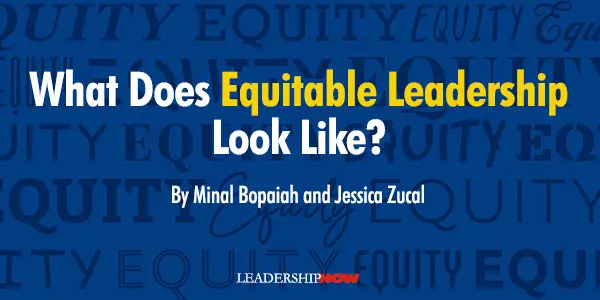
DURING the pandemic, one of us became a bit of a Star Trek fan. Minal was never really into science fiction, but she ran out of shows to watch and found herself intrigued when Stacey Abrams, who is famously a Trekkie, said that Voyager was her favorite Star Trek show, even though Deep Space Nine is considered the political allegory. Still, Abrams cited Voyager, and we can’t help thinking it was because of Captain Janeway. In Voyager, women finally had a realistic representation of female leadership aboard a Star Trek vessel, one that was determined and decisive but also empathic and willing to listen. Still, Janeway doesn’t seem like such a big deal until Minal had finished watching all the Voyager episodes and decided to dip into Star Trek: The Next Generation (referred to as TNG among Trekkies, we’re told). The first season is almost shocking in how Patrick Stewart’s Jean-Luc Picard carries himself. He’s brash and bossy and vents his frustration by shouting at children, particularly poor Wesley. In Picard, the recent revival of the Star Trek franchise, it’s clear the character evolves since season one of TNG. But we don’t think Captain Janeway would need to evolve as much if they revived her character. In fact, she’s almost a prescient paragon of what good leadership looks like in the 21st century. For decades, outdated models of Western leadership have prevailed, primarily centering White culture and male energy: someone who’s certain of himself, who has all the answers, who takes up space, shows no weakness, and knows how to win. But in a world turned upside down — by a pandemic, by climate change, by a reckoning with systemic injustice — what does winning even look like now? Leaders have been getting an inkling that things are changing, that the old tools aren’t working. They have tried to lead their staff through these changes by emphasizing we are more alike than different, that anyone who works hard can succeed here, and have been befuddled when staff respond with outrage or anger. So what exactly is going on? The definition and expectations of leadership have changed. Talented staff no longer want a general leading them into battle; they want a coach nurturing the best out of each of them. They want someone with the courage to be vulnerable and say, “I don’t know, but I’m committed to figuring it out with you.” They want an equitable leader. Someone who sees the system. Someone who is not tolerant of difference but rather so comfortable with it that they are willing to embrace it and make it a feature, not a bug of the workplace. They want someone who understands that great organizations encourage everyone to play to their strengths instead of insecurely asking everyone to fit into a mold of the “ideal” employee. However, our brains are wired to feel threatened by difference. In The Power Manual, Cyndi Suarez writes: The concept of difference is central to interactions in relationships of inequality. Humans have used differences to value, divide, and structure society—as with race, gender, class, age, and sexuality. One’s relationship to difference impacts one’s interactions, either reinforcing these structures of value or interrupting them. The supremacist approach to power offers two options for dealing with difference: ignore it or view it as cause for separation. A liberatory approach views differences as strengths and entertains interdependence as an option. How does one begin to nurture a liberatory approach to power? By examining your relationship to difference. Not surface-level differences—like a disagreement in approach or process to employ, the kind of difference that challenges your worldviews, your beliefs, and values. Leaders must navigate and embrace the latter to create inclusive and equitable environments where everyone thrives. And as Jessica has discovered through her work coaching leaders, this requires a higher degree of emotional intelligence, specifically, emotional self-awareness and the ability to self-regulate in the moment. The good news is you can build these muscles with intentional and consistent practice. Normalizing discomfort for yourself and your organization is critical. Why? Because experiencing deep differences often equates to deep discomfort, which triggers your brain’s fight or flight mechanism. In this mode, critical reasoning goes offline. You react out of habit verse skillfully responding from a place of choice. The work of the equable leader is to thoughtfully respond in the face of discomfort and to demonstrate openness for deep difference. Equitable leaders are also skilled at seeing systems and understanding interdependence. While valuing difference is the first step in the process of developing “system sight,” leaders can hone their vision by understanding their own relationship to the systems they are in. The tool Minal uses to facilitate this understanding with leaders is the Group Identity Wheel, developed by DEI practitioners and executive coaches Sukari Pinnock-Fitts and Amber Mayes. The wheel helps individuals understand themselves in all their complexity and positions their identity in relation to systems and power. It also allows them to understand both their marginalization and their privilege. This is vital to being an engaged and equitable leader. If a leader is interested in being an ally to people without the same level of privilege, then they must ask themselves, “How can I lift up the voices that may be struggling to be heard over mine in this organization?” This can be uncomfortable, which is why emotional intelligence is critical, particularly the stamina to do difficult things. It can be tempting to duck one’s head in the sand and simply believe that the outside world will not intrude upon your company. But ignoring reality makes you a poor role model for the courageous conversations we need to have if we really want to design a more equitable world where everyone thrives.  Jessica Zucal is a Senior Principal with Evans Consulting. As a change and transformation expert she works with leaders at the individual, team, and organization levels to build capacity for change and establish enabling conditions for success. Jessica is a NeuroLeadership trained coach and certified EQ-I 2.0 practitioner. 
Posted by Michael McKinney at 07:52 AM
05.12.21

Scenario Planning vs. Forecasting: 6 Questions to Ask to Prepare for a Post-Pandemic Future
AS WE finally start to see the light at the end of the tunnel of the catastrophic COVID-19 pandemic, many business leaders are looking for ways to better anticipate future disruptions and prepare for uncertainty ahead. There is often confusion between scenario planning and forecasting, with the terms used interchangeably and inconsistently. But these are different methods that involve specific activities, outcomes and value add. Scenario planning is focused on the future and involves defining different stories behind different paths that will lead to that future. You could also say it is based on a dynamic sequence of interacting events, causal processes, and critical decision points. It offers enhanced flexibility and preparedness to deal with risk and uncertainty instead of purely quantitative forecasting. It is about understanding multiple plausible futures without blinkers on, identifying what could happen, and describing that outcome in a compelling, engaging narrative. Scenarios are also collaborative—typically involving teams of people, often from various levels within an organization—and there is often a creative dimension, as opposed to being purely based on quantitative number-crunching. Scenarios provide longer-term, multiple futures based on unknown risks and uncertainties (e.g., the results of a U.S. election). Forecasts, on the other hand, are constructed on the assumption that the world in the future looks much like it does today. Forecasting is a less creative process and does not anticipate significant shifts in the business environment, which can cause considerable challenges for organizational strategy and a firm’s performance. Also, forecasts do not factor in risks and uncertainty as part of a broader stakeholder dialogue or research exercise. Instead, forecasting uses quantitative inputs and methodology to help predict what will, or should, happen in the future, mainly by interpreting historical data. Forecasting is a shorter-term tool that provides certainty based on known variables in the system (e.g., passenger traffic for airlines). To put it more bluntly: Forecasts offer one possible future, whereas scenarios offer multiple possible futures. Neither tool is better than the other; they simply offer different approaches to solving problems and should be used in a complementary way. The table below provides a more detailed contrast between scenario planning and forecasting, comparing various features and explaining the differences:
When deciding which tool to apply to a problem or opportunity, there are six typical questions that you can ask to help identify whether scenario planning or forecasting will be more effective:
As Paul Saffo, a technology forecaster based in Silicon Valley, said, “the goal of forecasting is not to predict the future, but to tell you what you need to know to take meaningful action in the present.” In a world of so many different management tools at the fingertips of leaders, it’s vital to ensure you select the right one to drive the outcomes you need to be successful.  
Posted by Michael McKinney at 11:11 AM
11.06.20

2020: The Opportunity of a Lifetime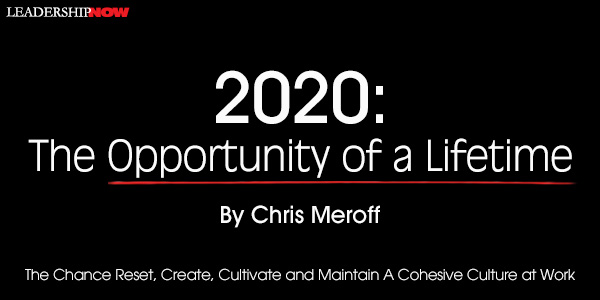
I AM A BIG BELIEVER that growth and transformation happens outside of our comfort zones. And this year has been anything but comfortable. Transformation is coming. This pandemic has wreaked havoc on our country in more ways than one. We are being forced to grow and adapt or fall by the wayside. While I am not advocating that a crisis is something to pursue, I do believe it forces us to grow in ways we would not have otherwise. This will be the greatest opportunity in our lifetimes to start over. A complete reset, to create, cultivate and maintain a cohesive culture at work. It can be a fresh start forced upon us by something out of our control. What has been a tragedy on many levels can be used for good. This can be life changing for so many. In order for transformation to come, we need to face reality for a second. If your company culture was toxic before, I can’t imagine what it will look like when you get back into the office. Dysfunction isn’t static. It’s either being addressed and fixed or it’s growing. Communication, which was likely already at a minimum in the workplace, became even quieter and more distant. If people were cynical and unhappy before, then what will getting back together look like? If they didn’t like their coworkers before, they won’t like them now. If they didn’t like their leadership before, they won’t now. Six months at home with their family, away from the drama around the office, and limited distractions has only reinforced their desire to stay as far away from the office as possible. A cohesive culture is impossible to achieve when your people aren’t at the office. So how do you make your company culture a place people are drawn to and not away from? Great cultures don’t just happen overnight. You can’t just hire your way to a fulfilled workplace of engaged employees and team members. There’s so much more to be done. It has to be strived for, all day every day. Conversations need to happen to establish what the purpose is, both for the company and the employee. We need to talk about where we want to go together and how we want to treat each other on the journey. Once we can agree to those things then we need to realign to them every single day. Everything we do should be done through the lens of purpose. If we can’t connect the task to purpose, then why are we doing it in the first place? A culture with a good purpose will protect itself.We need to affirm the intrinsic value in our people, choose to see the diversity they bring to the table and how we can achieve our goals by unifying together. These conversations won’t be casual breakroom talk or quick hallway catch-ups. They will be authentic and real unity driven conversations that foster community among employees and leaders. It is the role of a leader to get to know their people’s passions and soft skills—what makes them unique. Then learn how to apply those passions and soft skills to help us accomplish our purpose together. If we as leaders do this, we might look back some day and say that the silver lining, in a very difficult year, was the real and lasting change that made the workplace a destination, not just a means to an end.  
Posted by Michael McKinney at 09:38 AM
08.28.19

The Best Mentor You Can Find is Up to You!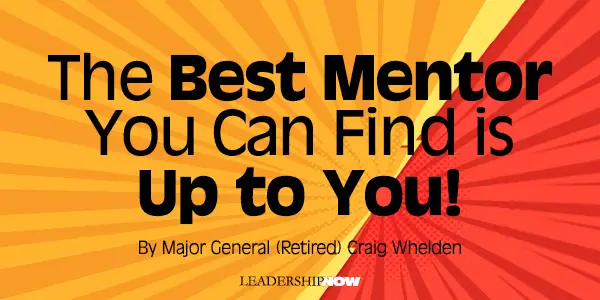
“The greatest good you can do for another is not just to share your riches but to reveal to him his own.” WHEN I WAS a young Army lieutenant, I met with my Assignment (Personnel) Officer, Major Tom Montgomery in Washington D.C. on my way to Germany in the summer of 1977. I never expected that he would become my first true mentor. There was no contractual agreement or even a discussion about such a relationship, and through all these years, I’ve never mentioned the word “mentor” to him. But, throughout our relationship, our conversations have given me volumes of knowledge about leadership and a host of other topics. I saw in him a leadership style similar to my own, just more seasoned. I wanted to learn as much as I could from him and use similar techniques as my own leadership responsibilities grew. He helped me get certain jobs and I worked directly for him once. We remain great friends to this day. Receiving mentorship is a vital element in learning about leadership… and being a mentor is a responsibility of all great leaders. I believe there are four types of mentors: assigned, self-appointed, sought-after, and what I call “virtual.” I have experienced all four. The first three are rather self-evident in terms of what they mean. What I’ve found the most valuable, however, is this last one, virtual. What do I mean? Virtual mentorship is something you do on your own. You simply pay attention to all of the people around you and learn from them. This can apply to both your professional and personal life. Pay attention to what others do or say that is particularly smart or good, then adopt it as your own habit. Notice also when a leader does something incredibly dumb or harmful to others, then put that in your leadership reservoir as well, so that you will never do the same. We’ve all seen good and bad behavior and said to ourselves: “If I ever get into that position, I hope I behave—or do not behave—like that.” Think of your life as a journey carrying a backpack, and observed behaviors are rocks you find along the path. Pick up both the good and bad—the good for future use and the bad to remind you not to repeat what those rocks represent. I’ve got plenty of rocks in my backpack—of both kinds—that I’ve picked up along my life’s journey. All great leaders learn something from those they encounter along their journey. It’s also a good practice to acknowledge those who provided meaningful lessons. I regularly cite those who taught me something that I now use myself. I also store away lessons that I want to avoid from leaders who I don’t want to emulate, though I generally refrain from naming them. Perhaps one of the greatest periods during which I learned from others was my time in the Pentagon in the late 1990s. My 23 years of service to that point had been exclusively within Army ranks, with no duty served in another military branch. But in 1996, when I became a new brigadier general, I was assigned to the Joint Staff in the Pentagon. I served during this time with a number of great military leaders who influenced me. Lieutenant General Pete Pace (later Chairman of the Joint Chiefs of Staff) was the J3 of the Joint Staff. I had to brief him each morning. My immediate supervisor was first Major General John Van Alstyne, then later Rear Admiral Tim Keating (who eventually became the Pacific Command Commander and Northern Command Commander as a 4-star admiral). Brigadier General Jim Conway (later Commandant of the Marine Corps) was a fellow 1-star and Colonel David Petraeus was the Executive Officer for the Chairman of the Joint Chiefs of Staff, General Hugh Shelton. Lieutenant Colonel Terry “Guts” Robling served there as well and would later become my boss as a three-star general when he commanded Marine Corps Forces Pacific and I was his civilian Executive Director. That was a particularly interesting relationship, as he was a lieutenant colonel when I was a brigadier general in 1996. While he didn’t report to me, we knew each other and occasionally worked together. Seventeen years later, I reported to him. I remember our first discussion in his office in 2013, where I made clear that while we had a different relationship in the Pentagon, I was perfectly fine working for him. I remember him saying he was, as well. He was very comfortable in his own skin. We got along great in the two years of his command tenure and remain good friends to this day. Good leaders don’t patent their behaviors; they willingly pass them on. I have borrowed many leadership techniques—perhaps most of them—from others who freely gave them up, and from some who didn’t even know I took them. Let your greatest legacy be that you pass on the best-of-breed leadership traits you’ve learned from others. I freely pass on mine. Many are in my new book, Leadership: The Art of Inspiring People to Be Their Best.  
Posted by Michael McKinney at 10:13 PM
08.22.19

Building Company Culture: Alignment Leadership
YOU PROBABLY HEAR the word culture a lot, but what does it mean? We’ll discuss it here but I can definitively tell you this: Without a strong company culture, you can’t create a fulfilling environment for your employees. In fact, the whole idea of culture is a moving target. Yes, it’s widely discussed, but somewhere between the discussion and the implementation something happens. Oftentimes that something is the watering down of the whole idea in the first place and casting it off as a soft science that doesn’t really impact the bottom line. Nothing could be further from the truth. What Is Culture? So, let’s begin at the beginning. What is culture? My definition of culture is the sum of a group of people’s beliefs, traditions, preferences, experiences, and hopes. Any time you put people together, a culture is created. Whether or not you agree with the traits of each person’s worldview—their beliefs, traditions, preferences, experiences, or hopes—that worldview exists. Every person has their own unique worldview, and the way they see the world combines with others to create the culture of that group. The individual traits of a person affect how they view the world and interact with others. For example, the word “trust” means one thing to one person and something different to another person, based on their experiences. The various meanings of trust within a group define their culture around that word. Imagine if a group of ten people working together had vastly different impressions of trust. What kind of culture would that create? Somebody has to clearly define it so that everyone knows what the end game is and how to achieve it. And take note that this is just one word and one idea that can be misconstrued. How many others are there that we assume there is agreement on? Don’t assume. Define. Create a common language and an agreed upon taxonomy that there is no doubt about. Get this right and your organization wins. Misconceptions about Culture Culture cannot be developed by simply creating environments where people congregate together. You’ve been at those events, right? Sometimes it’s a movie night or a day out on a boat or a team building exercise. These are usually great fun and they give us a chance to get to know each other away from the office. But, truthfully, this is just one step in creating a defined company culture. In my journey of leadership, this is a concept I fell prey to early on. In an effort to improve employee engagement, I created happy hours, pizza Fridays, and a party planning committee. What I didn’t realize was that without the initial investment in people before creating these events that fostered community, the experience would be a shallow attempt at culture. Alignment Leadership requires an intimate pursuit of employees, and this pursuit will never happen at a happy hour or a five-minute interaction while sharing a slice of pepperoni. As I began to develop this theory of Alignment Leadership, I realized the real win was much deeper—employee fulfillment. A happy hour can actually be an icebreaker to introduce someone into a community and build a deeper relationship. We go into these opportunities with the intention to further discover our employees, which leads to alignment. You want to develop a culture where you’re able to authentically allow your employees to be known, heard, and valued. Where to Start Creating a culture starts with conversations between you and your people to clearly define the culture you have—and the one you want to build together. You need to have conversations that clarify the culture of your team, the culture of your department, and the culture of the company. This needs to be perfectly understood both from the leader’s perspective and the employees’ perspective. Creating a culture won’t happen overnight. People’s worldviews are deeply rooted in who they are, and combining them into a culture that works for everyone will require people to make changes. It may take several years, but if you put in the effort to lead your team and work together, you can develop an authentic, meaningful company culture. 
Posted by Michael McKinney at 09:44 PM
08.20.19

Find Your Ideal Job and Build Your Dream Business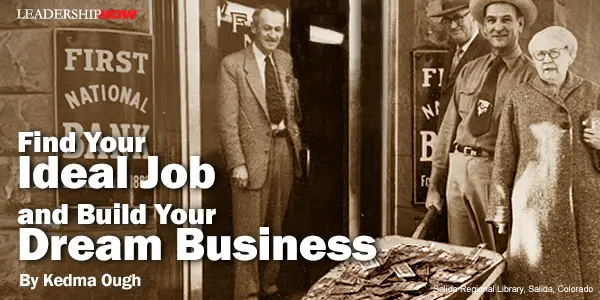
IS IT POSSIBLE to have your cake and eat it too? If there was a way to find your ideal job and build your dream business, would you consider both? Most people see this dichotomy and feel that they need to choose one dream over the other. The reality is that you can have both dreams so long as each doesn’t harm the other and enhances your lifestyle. Having worked with more than 10,000 entrepreneurs, innovators, inventors, hobbyists and side hustlers, they often struggle with when it is appropriate to leap from the job environment into the entrepreneurship maze. The presumption is that one has to sacrifice entrepreneurial dreams in order to be successful at a specific career choice. The truth is that you can have both and I strongly encourage aspiring employee-preneurs to review the following five reasons to consider maintaining your job in the first few years of building your business. 1. Learning from Both Work Environments: When you work as an employee and have a side entrepreneurial business, you can learn from both environments and both environments can benefit from each other. Often the entrepreneurial pathway is a lonely pathway and sole-preneurs in particular find themselves trying to navigate, learn and network to gain knowledge while building their business. Realizing that you can gain education from both environments allows an opportunity for you to thrive as an employee and manage a successful side hustle. 2. Business Ownership Strengthens Your Employee Net Worth: In most positions you rarely get the opportunity to experience the functions associated with the roles of a Chief Executive Officer, Chief Financial Officer, and Chief Marketing Officer, as well as manage the day-to-day requirements for customer engagement and retention. As a result of limited job functions in a large corporate environment, it doesn’t give you the full breadth of work involved in successfully managing an enterprise. By exploring the entrepreneurship maze you will quickly immerse yourself in all these functions, which will give you a better picture of the business itself, as well as an appreciation for the company that employees you. 3. Position Yourself with a Better Financial Portfolio: Quitting your job and then applying for a small business loan is a recipe for disaster. Often lenders expect borrowers to be fully collateralized. Having a successful employment position strengthens your probability of obtaining a loan or line of credit. While there are a lot of targeted small business funds that don’t require full collateralization, obtaining funds from your financial institution will be challenging if your debt to equity ratio does not meet their criteria and you don’t have a secondary source of income they can secure against the loan. In addition, being employed allows you the flexibility of investing in your small business without the stress of adding more debt into your current financial portfolio. Having the availability to set aside a few hundred dollars each month towards your business is significant when you have to consider paying for licensing, website development, social media support, etc. 4. Don’t Put Your Financial Eggs in One Basket: Diversifying your income allows you to mitigate financial risk and maximize your ability to make more money. Most people rely on their employment position for sole source income and if that position is compromised they may have a difficult time replacing those funds in a short period of time. Creating other opportunities to generate more money provides an additional financial cushion for investments or as an emergency fund program. The key is to target business concepts that don’t impose too much time on your part but produce a sizable financial return on your investment. Examples may include selling products online, starting a consulting business, or purchasing a semi-absentee franchise opportunity. 5. There Is No Need to Rush the Process: Most entrepreneurs believe they have to rush things to launch a company because they may lose out on the business opportunity. This may actually be a recipe for disaster. Rushing into a business concept without a proper feasibility review including competitive research, market analysis, and customer input is rushing to an unproven plan. Spending time building the foundation of the business allows for validation and a chance to identify the strengths, weakness, opportunities and threats of the proposed concept. Once the business has reached a certain consistent income you can decide whether to leap into the business full-time or hire others to manage the business. Ironically many of the Fortune 500 companies today began with entrepreneurs that started their business concept while working for an employer and then transitioned to their business slowly. Skin in the game does not mean you have to quit a job to explore a business. It means you have to be willing to invest time, money, or both in order to build your side hustle into a fledging small business operation. The great news is you don’t have to sacrifice either opportunity to benefit from both opportunities. You can have your cake and eat it too.  
Posted by Michael McKinney at 05:33 PM
07.25.19

How Innovation Is Completely Different in Established Organizations Than in Startups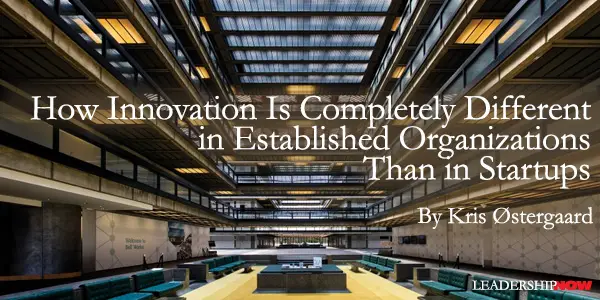
WE LIVE IN the age of the entrepreneur. New startups appear out of nowhere and challenge not only established companies, but entire industries. Where unicorns were once mythical creatures, the word unicorn now refers to the startups that have a value of at least $1 billion, and there are more than 370 of them worldwide. In 2018 alone, 53 unicorns were added to the list. Established organizations of a certain size and age, sometimes called “legacy organizations,” are stressed by the entrepreneurial successes. Their greatest fear is no longer their closest competitor, but the startups which, although they live in metaphorical garages and have hardly taken off, have an innovation power that established organizations can only dream of possessing. Still, no matter what great strides the innovative startups make or how much airtime they’re given by the media, innovation in startups is completely different than innovation in established organizations. The bad news for established organizations is that innovation for them is much more difficult than it is for startups. The most important job for startups is to focus on their (probably one) product and to subsequently scale up. Established organizations have to entertain many more considerations with their complicated product portfolios and business structures. The good news for established organizations, however, is that nobody is more likely to succeed than they are in their innovation efforts. Unlike startups, established organizations have tremendous resources. They have money, customers, data, employees, suppliers, partners, and infrastructure -- which put them in a perfect position to transform new ideas into concrete, value-creating, successful offerings. The Three Tracks of Innovation Many established organizations commit the mistake of engaging in innovation as if it were a homogeneous process. But innovation in established organizations must actually be divided into three different tracks: optimizing, augmenting, and mutating innovations. All three are important. There’s no one singular type of innovation that’s better than another. And, unlike the startups, established organizations must execute all three types of innovation at the same time. 1. Optimizing innovation: Improving the past. Optimizing innovation makes up the majority of what established organizations already do today. And they must continue doing so. Optimizing innovation is, simply put, the metaphorical extra blade on the razor. When the razor manufacturer launches a new razor that has not just three, but four blades, to ensure an even better, closer and more comfortable shave, only to announce one or two years later that it’s now launching a razor that has not only four, but five blades, that is optimizing innovation. This is where the established player reigns. No startup with so much as a modicum of sense would even try to beat the established company in this type of innovation. Continuous optimization, both on the operational side and the customer side, is good and important -- in the short term. It pays the rent. But it’s far from enough if the established company wants to continue to be a leader three to five years from now because there are limits on how many blades a razor needs. Each additional blade generates a bit less value than the previous one. Essentially, optimizing innovation improves upon the past. But startups are inventing the future. To match their entrepreneurial innovation power, established organizations must also prepare for the future and, ultimately, learn how to invent the future. 2. Augmenting innovation: Preparing for the future. To prepare for the future, the established players must engage in innovative augmentations. The digital transformation projects that more and more organizations are initiating can typically be characterized as augmenting innovation. It’s about upgrading the organization and its core offerings and processes from analog to digital. Or, if organizations were born digital, they may have had to become “mobile-first.” Perhaps they’ve even entered the next augmenting phase, which is to become “AI-first.” These augmentations are not small matters. They require great technological conversions. But technology may, in fact, be a minor part of the task. When it comes to augmenting innovation, the biggest challenge is most likely culture. Where startups have the advantage in building cultures from scratch that fit the times in which they originate perfectly, established organizations, who have had decades or even millennia of history, typically have created cultures in which there’s a preference to maintain the status quo. But if they hope to match the startup innovation power, they will need to transform their cultures to ensure their employees all thrive in constant change. 3. Mutating innovation: Inventing the future. Finally, established organizations also need to invent the future through mutating innovation. The business that maintains or exceeds its level of success 10, 20, and 30 years from now will have mutated. Whatever is currently at the core of the company today, making up the majority of the top and bottom lines, won’t remain the same in the long run. Mutating innovation requires a bold focus on experimentation into what isn’t yet understood. This is where the successful startups have excelled -- taking what exists and challenging it to either create something new with more value or open up to new target groups. For established organizations, this innovation track is difficult because it essentially challenges their identities. Therefore, mutating innovation cannot thrive inside a company’s core, but needs to be taken outside to the core organization’s edges. Tools to promote mutating innovation can include establishing labs or X-divisions. Alphabet has excelled in this approach, but other legacy companies are also increasing their experimentations. DIY chain Lowe’s, for example, is building 3D printers that print in zero gravity, thus opening up entirely new markets for themselves. Japanese airline ANA commissioned a global competition via the XPRIZE Foundation to create the future of travel that has now resulted in targeting the next big market: Space. As game-changing innovation is at the core of these efforts, both startups and established organizations can find common ground in working together. The established companies want access to the startups’ technology expertise, while the startups want access to the established companies’ customers and data, this can be a match made in heaven. Becoming the Innovation Champions of the Future Ultimately, if startups turn to scale-ups and succeed, they’ll fast become established organizations with very complex systems, requiring them to change their innovation strategies and entire organizations to remain successful. For Alphabet, even though the company is only 20 years old, this has already happened twice. It moved from a search engine to advertising to spawning off autonomous vehicle and health care companies that may turn into the new cores of the organization. Similarly, Apple is in the process of transforming from hardware into an entertainment company, and Amazon, perhaps the master of mutation, continuously adds new layers to its complex structure. For the legacy organizations of the world, they must learn from these examples, dare to challenge their status quo cultures, and ensure that they can engage in optimizing, augmenting and mutating innovation at the same time if they are to become innovation champions of the future.  
Posted by Michael McKinney at 01:27 PM
07.12.19

Employee Engagement 101: Ask the Holy Question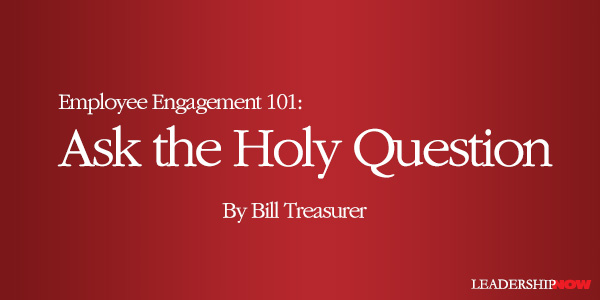
HAVE YOU EVER heard a front-line worker say, “I can’t wait to make more money for our shareholders today!” No? In all my years as a consultant, I haven’t either. It doesn’t matter what your company peddles. Increasing shareholder value, company market share, or worker productivity just doesn’t jazz the average worker. There is often a vast disconnect between what is important to a company’s executive body and what is important to front-line workers. What matters to the average worker includes career opportunity, meaningful work, a balanced life, a fair wage, and being treated with respect—not increasing output. As a leader or manager, you have to attend to the goals of your board or bosses and to the career aspirations of your workers. Too many people in charge focus solely on the former, leaving workers’ aspirations in the dust. A Solution in Four Words Cueing into your workers takes far less time and energy than you’d think. In fact, it only takes four words. They are among the most important words in the English language, and, together, they constitute what I call the Holy Question: “What do you want?” Answering those words, in my opinion, should be required of every job candidate, every worker, and every executive on up the line. The answer to those words should be reviewed during every performance appraisal, succession-planning session, and employee-ranking process. Why? Because when you know what people want, you are in a far better position to match their ambitions and goals to the company’s goals. When company and worker goals are aligned, people pursue organizational goals with the same dedication and passion as they do when driven by self-interest. Aligning Goals Increases Workers’ Courage It’s easier to get people to perform courageous (and uncomfortable) tasks when those tasks tie into their personal aspirations. By knowing what people want to get out of work, you can give them stretch assignments that connect project tasks to their own goals. So, if your boss’s goal is to “repurpose our existing product assets to create new revenue streams and optimize our market dominance on a go-forward basis,” you can tie your boss’s goal to your employee’s own career aspirations by saying, “Hey, John, you said that you want more opportunities to use your creativity. Create ten new business uses for this product by next week.” Or perhaps you know that your employee Michelle would like to move from a data analyst to an advisory role. Your board has come to you needing an informed opinion on the latest sales metrics—and fast. It’s the perfect opportunity to bring Michelle into the fold, allowing her to provide a fresh perspective while simultaneously gaining experience for her dream role. The point is this: Before getting workers to carry out tasks in pursuit of the company’s objectives, you have to understand what is important to them individually. How would you answer the question of “What do you want?” How would your boss answer it? Your customer? Each of your direct reports? Getting each person to answer the Holy Question, with specificity, will help you to know when and how they’ll be willing to be courageous. 
Posted by Michael McKinney at 02:09 PM
07.10.19

How to Be an Engaging Leader in a World of Robotics, AI, and Digitization
MANY of today’s leaders are saying: I know leadership is about people, not tasks; effectiveness, not efficiency. However, the rapid increase of robotics, AI, and digitization are a disruption. It’s leading us to increased depersonalization and disengagement with our employees. How do I keep the digital demands of today from overwhelming my business? I want to keep my best people engaged, remain competitive, and stay on the growth path! If these are your feelings, you are not alone! Many business leaders are perplexed by the task of leading in an ever-increasing technological world. Yes, we are leaders of people, and yet it feels as if technology and other digital demands keep us from investing in our most valuable resource, our people. In the midst of managing these exponential leaps in technology, there is a war for talent. We are challenged to attract, engage, and retain top-tier millennial talent – the fastest growing segment in our workforce. However, Millennials, the techno-wizards, are not necessarily happy either. Here’s the paradox: Millennials are stepping into a world where one of the things they are good at—technology—may well be one of the things that hurts them most and undercuts their ability to flourish. They are living in a world where the predictions are that robots will soon take over their jobs. It feels as if we’re getting mixed messages from the top. Do we need to choose between attracting and engaging top millennial talent and installing new, state-of-the-art technology? Not every industry needs the latest artificial intelligence, but everyone is feeling the pinch of staying on the leading edge of technology. How can we be an engaging leader in a world of robotics, AI, and digitization? The Benefits of Engaging Leadership According to the 2017 Gallup Workplace Report, employee disengagement is alarmingly high in America. They report that just over 30 percent of participants are engaged (love their jobs), 16 percent are actively disengaged (miserable and destroying what others are building), and 51 percent are not engaged (they’re just there). In 2016, the Society for Human Resource Management made a compelling case about the benefits that come from an engaging leadership approach: • 22 percent greater profitability
Millennials are reminding us of what the research shows – no matter how important the new AI or robotics system is, in order to attract, engage, and retain them, we need to do three important things. Prioritize the Person, as Well as the Technology “I want to be treated as an individual – not as a trend or a robot.” Listen deeply. Listening is a tangible action that engaging leaders employ to demonstrate that they value the Millennials in their sphere of influence. They listen…then collaborate on how they might support their emerging leader’s goals to leverage their strengths, nurture their natural skills, and achieve their career goals. Here’s the challenge. As experienced leaders, we have a wealth of knowledge, wisdom, and insight that we are excited to share with our younger counterparts. But what happens when we talk, and talk, and talk…and don’t listen? Our emerging leader loses trust. Then, they disengage. Why? Trust is at its lowest when we talk 75 – 80 percent of the time, and listen only 20 – 25 percent of the time. What might happen if we spent 20 – 25 percent of our coaching and managing time asking insightful, probing questions, and then listening? Practical experience has proven that active listening improves collaboration, deepens relationships, and boosts productivity. By prioritizing and seeking to understand what makes your emerging leader flourish, you spark engagement. Plus, you will gain even further insights from them on how to leverage technology to gain to tap new markets, gain market share, and enhance the customer experience. Align Vision and Values “I want to understand your vision and values so that I know how I’m making an impact. I want to be part of something bigger than the job you’ve hired me to do.” Tapping into the goals, dreams, and aspirations of their Millennials – and create align with their company’s vision and values – is a driver for engagement focused leaders. Emerging leaders often feel stuck and can’t see beyond the perceived drudgery of their ToDo List. They may struggle seeing how their everyday work has meaning and purpose. The result? Disengagement. Reverse this trend by helping them see how they, and the work they are doing, fits into your company’s larger purpose. The clearer the picture is to them on how they are helping your customers and how they are making the world a better place, the more engaged they will be. They will live with high regard for their work, bringing fresh, human compassion, insights, and connection to a high-tech world. Value Two-Way Mentoring “I want to be more than a digital number in your database who gets a monthly paycheck. I want leadership that values my opinion and is geared to my career development opportunities.” Two-way mentoring means that we seek not only to teach and train our emerging leaders, but also to learn from them. Millennials thrive when they get clear guidelines and feedback that shines a bright light on what they’re doing right. This creates a learning pattern for them of recognizing their strengths, re-creating it, and refining it. Bring them into brainstorming and problem-solving processes. Their insights can assist you in developing new products and services, as well as create openings in new markets. We might not want to admit it, but they have important insights for us to consider that test and rethink our own paradigms about how to lead well in the rapidly shifting world. Summary The disruption of digitization, robotics, and AI is here to stay. That does not mean that your role as a leader of people will become obsolete. In fact, your role will become even more indispensable. As the war for talent continues, you can come one step closer to winning that war by becoming an engaging leader. The time has come to start listening to the emerging leaders so that we learn about their strengths. Give your Millennial clarity on his or her role, and create a win-win scenario by establishing yourself as a leader who wants to learn. You have the experience and resources to counteract the depersonalization and disengagement phenomenon. Keep your best people engaged, remain competitive, keep up with the demands of technology, and be poised for growth!  She is a member of Forbes Coaches Council, is a leadership and sales development expert and author of the new book, Millennials Matter: Proven Strategies for Building Your Next-Gen Leader.
Posted by Michael McKinney at 10:20 AM
06.17.19

Do You Trust Your People?
THE GREAT WRITER Ernest Hemingway once said: "The best way to find out if you can trust somebody is to trust them.” I’ve often told people in new organizations I joined that I trust them until that trust is violated. This puts a healthy kind of pressure on them NOT to violate that trust. Stronger performance is often the result. Here are two stories that demonstrate the value of trust: one that reflects what happens when there is no trust, and another that reflects the tremendous performance and learning that comes when there is trust. When No Trust Exists In 1992, I was the G3 (Operations Officer) for one of the Army’s 10 Divisions – forward deployed in Europe. Within a year in the job, I led a military-to-military exchange trip to Hungary, one of the satellite countries of the former Soviet Union. The Cold War had ended, and we were now opening the aperture to Eastern European countries that had been coerced into the Warsaw Pact decades earlier by the strong arm of Russia. After the Berlin Wall fell in 1989, General George Joulwan, the Supreme Allied Commander of all military forces in Europe, established a program called “Partnership for Peace” or PfP. His idea was to reach across the former Iron Curtain so new relationships could be forged between the U.S. and its former foes. The goal was to pull the Warsaw Pact nations out of Russia’s sphere of influence and into ours. My trip was the first such effort the U.S. military did with Hungary, and I was able to witness the difference in approaches to trust between the US military and the Eastern European military—and, by extension, the Russians, since Soviet satellite countries’ military dogma mirrored the mother ship. The Hungarians were truly trying to impress us when they showed us their weaponry, but they were seemingly unaware that the decades-old equipment they had was far inferior to ours if they had to face us in war. The Russians had given frontline nations in Eastern Europe the oldest and least capable equipment, saving the best for themselves. Soviet satellite countries such as Hungary, Czechoslovakia, Poland, and East Germany—rolled into the Soviet arc after World War II—were frankly viewed as cannon-fodder by the Russians. Although I was only a lieutenant colonel at the time, I was treated like a general. Everywhere I turned, only officers (majors and above) were briefing us. They had little trust in their more junior officers and sergeants, like the U.S. places in our junior leaders. Russian influence was everywhere, and the lack of trust and regimentation contrasted sharply with the way the U.S. military operates, where mission orders are issued along with the commander’s intent, thereby giving subordinates the freedom to operate within that framework. In the U.S. military, it’s all about trust and empowerment. I saw little of that in Hungary. A few months later, we reciprocated by bringing senior military leaders from Hungary to our bases in Germany. Most of these delegations consisted of colonels and generals. They were shocked when we turned them over to our sergeants (who actually gave the briefings) and even more shocked when we let them mingle with our troops—out of our earshot—to see what U.S. soldiers were really like. General Joulwan’s approach obviously worked, as a number of former Soviet Union countries are now members of the North Atlantic Treaty Organization (NATO): the Czech Republic, Poland, Bulgaria, Estonia, Latvia, Lithuania, Romania, Slovakia, Slovenia, Albania, Croatia, and Montenegro. And yes, Hungary. When Trust Exists I soon found myself on the list for both colonel and command. My boss called me in one day and told me that I had been selected to command a base. In fact, it was the base we were on: the 98th Area Support Group (ASG), headquartered right there in Wurzburg, Germany. Though I knew little about running a base, it took me just a few months to realize this turn of events was the best thing that ever happened to me. Over 95 percent of my 3,000-person workforce was civilian, half were females, and an equal number were German nationals. I was like a “town mayor” serving more than 45,000 constituents and customers. My leadership style needed to adapt to this very different environment, or I would fail. I was joining THEIR team and needed to learn quickly how to adapt to THEIR environment. Commanding a base required me to put trust, faith, and confidence in a workforce that knew much more about the tasks at hand than I did. I had to lead the team, but at the same time, I had to have confidence that their shared feedback and advice to me was of value. They needed to know that I trusted them. The leadership skills I employed at that time had little to do with the technical aspects of running an Army base, but rather, those that required skills in simply leading people; something I had spent 20 years honing. I found myself praising and encouraging what was working well, and just as importantly, I sought to learn what was not working well and how we could make it better. It wasn’t difficult sorting out the two, as all I had to do was pay attention to those on the receiving end of what we provided. Simply put, I listened to my “customers.” They could be very vocal when something wasn’t right. I understood this well since I too had been a customer of the community for the previous 18 months. This very different experience helped me grow as a leader and prepared me for the rest of my time in uniform and beyond. One of the keys to my success was rooted in the trust I showed my team. It was paid back in exceptional performance. It should be intuitive to most leaders that the higher you climb up the corporate ladder, the greater the reliance you must have on those below you. Support your team and let them do their job, and you’ll be amazed at what they give back. That’s what I tried to do in the 98th ASG, and it worked. It can work for you as well.  
Posted by Michael McKinney at 09:10 AM
05.17.19

Do You Need an Attitude Adjustment?
HAVING A POSITIVE ATTITUDE is a critical element of leadership. To some, this comes naturally. Others must constantly work on it. Since my earliest memory, I have had the sense that anything worth doing… worth pursuing… must be passionately pursued. A positive attitude naturally follows. I found myself first assuming leadership responsibilities at age 14 when I became an Eagle Scout. Perhaps I was naïve, but the leadership aspect of this achievement was unexpected. For me, getting there was just a mountain to climb. It was the culmination of 21 merit badges and a large community project. It was the excitement of the journey, the arrival at a destination, and the achievement of the reward. For me, at 14 years old, it was like reaching the top of Mount Everest but with no real thought (or plan) on how I was going to get back down… the part of the climb where most people die. Once there, I didn’t quite know what to do with these newfound responsibilities when people started turning to me to lead. But it did help jump-start a lifelong journey to develop and sharpen my leadership skills—a journey that really never ends. Great leaders constantly deal with the struggle between achieving personal goals, while doing so with humility. Ask yourself, “Do you want to achieve lofty goals in order to ‘climb the mountain’ or do you want to get on top of the mountain so that you can help others climb their own mountain?” How can you do both? In high school, I held leadership roles in school government and on the sports field. In my senior year, I was voted “Best All-Around” and “Most Dependable”—the latter accolade drawing raised eyebrows from my parents! At Purdue University, I was President of the Freshman Council at the largest school dormitory, President of my Fraternity Pledge Class, and Vice President of Purdue’s Interfraternity Council. (I ran for President, but was asked by the Council whether I would take the VP spot if not selected to be President. My agreement sealed my fate). All these experiences helped shape my thinking about, and commitment to, leadership because people started to turn to me to lead. I had the right attitude throughout these early years. However, there came a period in college when I lost my way. My attendance at Purdue was facilitated by an Army ROTC scholarship, at a time when the Vietnam War was stoking nationwide protests across nearly every college campus. Compared to other campuses, Purdue was a fairly conservative school, but we had a chapter of the Students for Democratic Society (SDS), and they regularly protested the war on the mall or at the Armory. I had mixed feelings about the war when I arrived at Purdue in 1969, having spent most of my high school years in Europe—insulated from the anti-war movement. But since I had an ROTC scholarship and my dad was retiring from the Air Force and starting law school about the same time I entered college, I felt an obligation to stay in a program that was paying my way. I also worked 4 hours each evening (Monday - Friday) as a janitor, cleaning the second floor of the university library to help make ends meet. Then an unfortunate event happened. Because of my student government activities, my leadership role in the fraternity, and my work schedule (combined with ambivalence about the war), I didn’t participate in any ROTC activities outside the classroom. Just walking across campus in uniform to attend military drills drew unwanted attention. So, when the annual Army ROTC awards ceremony occurred in the spring of my freshman year (1970), and knowing that I was not an award recipient, I decided to skip the ceremony and attend the SDS rally in the mall instead. Not my brightest moment… That day, after chanting “1-2-3-4, we don’t want your F*#king War!” over and over again, a growing crowd of about 1,000 decided to march on the Armory, where the ROTC awards ceremony had been moved to insulate it from the protests. I followed the crowd. Upon arriving at the armory, they broke open the large truck-sized doors and entered, chanting loud and strong. State troopers in riot gear soon arrived to keep the protesters away from the formation of cadets. I was not an active protest participant, and naively thought of myself as being in some kind of “intellectual exercise,” but one of my instructors saw me, that day. He called me in the following morning and told me that my scholarship was being put on probation. This was a wakeup call for me, and it began the reshaping of my attitude. I had to decide which side to be on. I came to realize that I wanted to be a leader more than a protestor. Like some other Americans, I may have thought that the Vietnam War was ill-advised, but I also realized that there were alternative ways to make my mark on the world. When ROTC summer camp training rolled around between my junior and senior year, I spent nine weeks at Fort Riley and did well enough to become the third-ranking cadet at Purdue during my senior year. Upon graduation from Purdue in 1973, I was one of six cadets designated a Distinguished Military Graduate. So, what should you take from this ROTC experience? In a nutshell: attitude counts. A lot. There’s something to be said about the oft-repeated mantra that “you can be whatever you want to be.” That said, all aspects of character: ambition, perseverance, self-awareness, empathy, humility, integrity, and always taking seriously the responsibility of being a leader—often while sacrificing personal welfare or gain—are required if you’re to be the best you can be. You need building blocks to realize that dream. During those early years at Purdue—at least as it applied to an Army career—I lacked ambition, a good self-awareness, and perseverance. I lacked “grit.” I simply knew that I owed four years to the Army after graduation because of my scholarship, but after that, I thought I could move on to something else. Once I finally decided to “get on board,” my ambition, perseverance, and self-awareness kicked into high gear. I then adjusted my attitude, and a 4-year commitment turned into a 30-year career.  
Posted by Michael McKinney at 12:01 AM
04.05.19

Why Leaders Need to Think More Like Professional Gamblers
ONE OF the unfortunate side effects of living in an age of accelerating technology is having to deal with increased uncertainty. When faced with uncertainty, how should leaders react? Should they make a big bet, hedge their position, or just wait and see? We tend to see situations in one of two ways: either events are certain and can, therefore, be managed by planning, investment, and reliable budgets; or they are uncertain, and we cannot manage them. You can, however, embrace uncertainty by adjusting your views as new information becomes available. In order to do that, you need to learn something about Thomas Bayes, an English clergyman, and mathematician who proposed a theorem in 1763 that would forever change the way we think about making decisions in ambiguous conditions. Bayes was interested in how our beliefs about the world should evolve as we accumulate new but unproven evidence. Specifically, he wondered how he could predict the probability of a future event if he only knew how many times it had occurred, or not, in the past. To answer that, he constructed a thought experiment. Imagine a billiard table. You put on a blindfold, and your assistant randomly rolls a ball across the table. They take note of where it stops rolling. Your job is to figure out where the ball is. All you can really do at this point is to make a random guess. Now imagine that you ask your assistant to drop some more balls on the table and tell you whether they stop to the left or right of the first ball. If all the balls stop to the right, what can you say about the position of the first ball? If more balls are thrown, how does this improve your knowledge of the position of the first ball? In fact, throw after throw, you should be able to narrow down the area in which the first ball probably lies. Bayes figured out that even when it comes to uncertain outcomes, we can update our knowledge by incorporating new, relevant information as it becomes available. Many years later, French mathematician Pierre-Simon Laplace developed Bayes’s idea into a powerful theory, which we now know as the Bayes Theorem. Here is a simple explanation of it. Beginning with a provisional hypothesis about the world, assign to it an initial probability of that event happening, called the prior probability or simply the prior. After collecting new, relevant evidence, recalculate the probability of the hypothesis in light of the new evidence. This revised probability is called the posterior probability. You can find evidence of Bayesian thinking throughout modern history, from nineteenth-century French and Russian artillery officers adjusting their cannons to Alan Turing trying to crack the German Enigma codes. Bayes has even influenced the design of machine learning techniques, notably the naive Bayes classifier. Bayes is relevant to modern leaders because it can help them develop an approach to uncertainty that is less deterministic and more probabilistic. Even when events are determined by an infinitely complex set of factors, probabilistic thinking can help you identify the likeliest outcomes, and so make the best decisions. Viewing the information probabilistically enables you to describe one of many possible outcomes, some more or less likely than others. One of the key advantages of thinking probabilistically is that it equips you with a more critical perspective to evaluate new data as it becomes available. Data can be imperfect, incomplete, or uncertain. There is often more than one explanation for why things happened the way they did; by examining those alternative explanations using probability, you can gain a better understanding of causality and what is really going on. Deterministic models produce a single solution that describes the outcome of an experiment given appropriate inputs; in other words, for every possible input, there is a single output. A probabilistic model distributes over all possible solutions and provides some indication of how likely it is that each will, might, or can occur. The human mind is naturally deterministic. We generally believe that something is true or false. Either you like someone, or you don’t. There is rarely a situation when you can say that there is a 46 percent probability that someone is your friend. In fact, unless you are a teenager and have a lot of frenemies, you are probably quite deterministic about your social circle. Our instinct for determinism may well have been an evolutionary innovation. To survive, we had to make snap judgments about the world and our response to it. When a tiger is approaching you, there is really not a lot of time to consider whether he’s approaching as a friend or a foe. However, the deterministic approach that kept our ancestors alive while hunting in the savannah won’t help you make good decisions in complex, unpredictable environments when your natural mental shortcuts and heuristics start to fail you. One of the best ways to embrace uncertainty and be more probabilistic in your approach is to learn to think like a professional gambler. Take, for example, Rasmus Ankersen. Ankersen, a Dane living in London, originally came to the UK to look for an English publisher for his book on human performance, the writing of which had taken him from Kenya to Korea in search of why great athletes, whether they are runners or golfers, tend to come from the same small regions. One of the reasons he decided to stay in London was a chance meeting with a professional gambler named Matthew Benham. Benham is a renowned, albeit somewhat inaccessible, figure in the British gambling world. After graduating from the University of Oxford with a physics degree, he went into securities trading, first at Yamaichi International and then at the Bank of America. This was followed by a stint working as a trader for Premier Bet with Tony Bloom, one of the most successful gamblers in the world. That inspired Benham to leave his day job and focus on gambling. He went on to start two successful gaming companies, Matchbook, a sports betting exchange community, and Smartodds, which provides statistical research and sports modeling services. When Ankersen and Benham met, they started talking about how soccer (except, of course, they called it football) was a sport that was yet to be disrupted by data and probabilistic thinking. Benham was impressed enough to invite Ankersen to help run Brentford Football Club, which he had recently acquired. Soon after, Benham also bought Midtjylland, the soccer club in Ankersen’s hometown. Ankersen’s insight was this: soccer is one of the world’s unfairest sports. Although there is a saying that “the league table never lies,” in Ankersen’s opinion that is exactly what it does. Because soccer is a low-scoring sport, the win/loss outcome of a game is not an accurate representation of the actual performance of a team, and therefore the intrinsic value of its players. From a professional gambler’s perspective, the key to placing a good bet is to continually update your position with relevant insights that impact the probability of an event occurring. Rather than trying to be right, gamblers try to be less wrong with time. Benham and Ankersen started to use the scientific application of statistics—the “Moneyball” technique pioneered in baseball— when assessing the performance of a team. Their key performance metric became “expected goals” for and against a team, based on the quality and quantity of chances created during a match. The point of this exercise was to develop an alternative league table, which might serve as a more reliable predictor of results and a better basis on which to value and acquire players. As an algorithmic leader, you will also find having a probabilistic mindset useful, and not just when you want to place a bet in the office fantasy soccer competition. Let’s consider a few examples. A probabilistic HR manager will examine the data about where a company’s best people come from and how they perform throughout their career to identify new sources of talent that may have been overlooked. A probabilistic sales professional will be conscious that it’s not enough to simply close lots of deals; it’s important to also think about where leads come from. How many opportunities were created organically, as opposed to being fed through an existing pipeline? How many new customers churn after just a few months? By understanding the data around which leads go on to become great customers, a sales leader can then work closely with their marketing colleagues to figure out new sources of potential customer prospects. Probabilistic risk managers will think about the future of how they work. While their job may have been setting or applying strict credit policies in the past, they may now start to wonder whether their traditional credit rating models are still effective. Are there low-risk segments in their customer base that they may have missed and that a new competitor may be able to target? Developing a probabilistic mindset allows you to be better prepared for the uncertainties and complexities of the algorithmic age. Even when events are determined by an infinitely complex set of factors, probabilistic thinking can help us identify the most likely outcomes and the best decisions to make. 
Posted by Michael McKinney at 07:16 AM
03.08.19

Lessons in Leadership to Last a Lifetime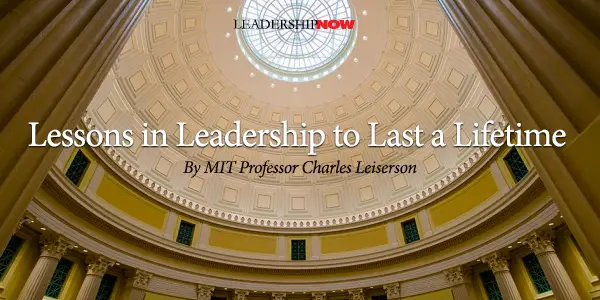
AFTER 18 YEARS on the MIT faculty, I thought I knew a thing or two about leadership. After all, I was tenured and had supervised dozens of students seeking undergraduate and postgraduate degrees. But in 1999, at the height of the Internet boom, I took a two-year leave of absence to serve as director of system architecture at Akamai Technologies, an MIT start-up located here in Cambridge. That position humbled me and taught me lessons about leadership that I still use today, some 20 years later. Back then, the vast majority of Akamai’s 100 engineering staff had been recruited directly from MIT and other top universities. Like me, most had only worked in academia up to that point, and we assumed our corporate roles and responsibilities with anticipation and a healthy dose of swagger. What could possibly stop this juggernaut of collective brilliance? Well, one collective deficit could, and did: The lack of effective leadership. You see, despite their immense talent, our teams were completely dysfunctional. Within weeks, people started to feel disgruntled, and then even worse—angry, jealous, vindictive. Morale sunk, and our productivity did, too. Fortunately, Akamai’s VP of Human Resources, Steve Heinrich, recognized what was happening and brought in Chuck McVinney, a management consultant with expertise in teamwork and leadership training. Chuck began teaching the engineering leaders about topics we had never been exposed to before: situational leadership, dealing with diversity and conflict, providing effective feedback, fostering creativity, and how to build a motivated team that leverages individual talents. Remarkably, after only two off-site workshops, our teams started to function better. We were able to focus and work collaboratively toward our goals. The workshop content wasn’t complicated, but if you’re currently running a research lab, odds are, you’ve never seen it. That’s because academia and other research organizations rarely offer leadership and management training—and as a result, far too many engineers and scientists waste their time and resources dealing with unproductive interpersonal issues and unnecessary conflict. To help right that wrong, here are five the most important lessons I learned while at Akamai, all of which I continue to use in my lab today: Research is a human endeavor
Know thyself
Mental diversity strengthens teams
Communication is key—and it involves effort
To keep leading, keep learning
It’s been about 20 years since I returned to MIT from Akamai, and businesses now routinely spend billions of dollars per year teaching employees “soft” leadership skills like the ones I just listed. If universities and other research organizations would invest even a fraction of that, their labs would be a more enjoyable place to work and their teams would be more creative and productive. 
Posted by Michael McKinney at 12:04 AM
12.17.18

What a Mechanical Shark Can Teach Us About Leadership and Innovation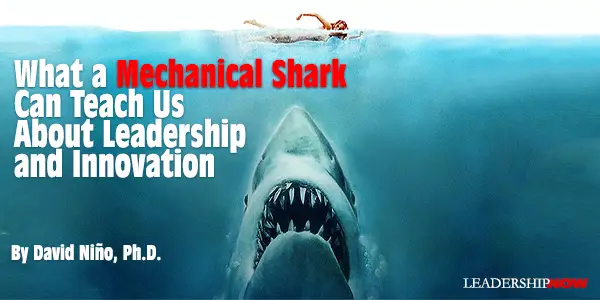
O But this wasn’t the film itself. It was a documentary on the making of the movie, all about the lengths that then 27-year-old wunderkind Steven Spielberg and his crew went to in creating a film that would define the summer blockbuster. I soon learned that this scene – one of the best known in the entire film – isn’t what Spielberg initially had in mind. In his original vision, viewers would be treated to a gory scene of the mechanical shark visibly attacking the unassuming woman. But “Bruce,” the mechanical shark, kept malfunctioning, and so the director had to find another way to tell his story. Spielberg could have insisted on the shot. After all, this was the scene he needed to “hook” the audience and keep their attention throughout the entire movie. He could have bawled out the engineers and technicians behind the mechanical prop, demanding that they somehow find a way to carry out his vision. But he didn’t. Instead, he brainstormed with the talented people around him and came up with a new vision – one that was just as compelling as the original, and with the added bonus that it would actually work. The result: One of the most memorable scenes in cinema history. This happened over and over again during the production of “Jaws,” with Spielberg and his crew forced to alter – or completely abandon – the director’s original vision to adapt to conditions on the ground. They had to improvise, making up major new scenes as they hit major new problems. As I watched the documentary, I was struck by how closely the story mirrored case studies from the business world, and how perfectly it illustrated the points I try to emphasize in the leadership and innovation class I teach at MIT. In business, we tend to mythologize innovative leaders as those who have a revolutionary vision and stick with it, no matter what. But, as Spielberg’s mechanical shark illustrates, the truth is frequently far more complex. In fact, an original, revolutionary vision isn’t innovation at all (and it certainly isn’t leadership). No, those fresh, once-in-a-lifetime ideas are examples of pure and raw creativity. And while these original sparks are surely important, they usually don’t stand up all that well to the pressures of reality. Anyone with experience with the unforgiving discipline of new product development can testify how exceedingly rare it is for even the best of ideas to emerge from that process unscathed. Creating something new is almost never a simple matter of dreaming a thing up and then building a physical representation of that vision. Nearly always, the process is an iterative one, full of trial-and-error, with more failures than successes. In one famous example, Thomas Edison had to teach himself thousands of ways not to make a light bulb before finding a way that worked. Innovation, then, is less about having original ideas than it is about being able to execute those ideas. It’s about delivering what customers will buy or use. Friendster’s founders had a creative concept, for example, but it took the minds behind Facebook to turn a similar idea into what is now one of the world’s largest companies. Henry Ford didn’t have the creative spirit that led to the invention of the automobile, but his innovative leadership resulted in a level of execution rarely matched in the history of manufacturing. In fact, even the assembly line was inspired by Ford’s observations of the meat slaughtering process, and how workers in that industry were organized to divide up the whole animal into pieces. Similarly, Spielberg borrowed from his idol, Alfred Hitchcock, in exploiting the terror of the unknown. One could, perhaps, cite these influences as dings against Ford’s and Spielberg’s creativity. But their willingness to lean on and learn from others’ ideas is a large part of what makes them such innovative leaders. If innovation is really about execution, then execution itself is really about problem-solving. Inevitably, problems pop up that stand in the way of a leader’s original vision: The bulb won’t light up; the customers won’t buy; the mechanical shark won’t work. The difference between ultimate success and failure is the ability to solve these problems. In fact, I would go a step further and say that the mark of an innovative leader is often his or her ability to redefine the problem – to see it in a new way that presents previously unseen solutions. Spielberg’s genius lies in his ability to recognize that his central problem wasn’t how to make a mechanical shark work, but rather how to terrify his audience. There’s a delicate balance at play here – what I sometimes call the “paradox” of leading innovation. On one hand, leaders must trust in themselves. They can’t be so wishy-washy that they’re willing to abandon an idea or strategy at the first hint of difficulty. But at the same time, they must be willing to surround themselves with talented people and place real trust in their teams to help them recognize problems and arrive at solutions. That’s what Spielberg did, staying up late with his crew night after night, devising new shots over beer and whiskey when the original storyboards had to be trashed. In the documentary, Spielberg said that all of the accolades and big-budget movies that came to him throughout the rest of his prolific career (one that includes directing credits on “E.T.,” “Jurassic Park,” and “Schindler’s List”) were made possible by the success of “Jaws.” And that success was due to his willingness to be flexible – to modify his vision through collaboration on his way to redefining the summer blockbuster forever. 
Posted by Michael McKinney at 10:32 AM
11.21.18

How to Bring Gratitude into the Workplace
‘Tis the season of gratitude -- for friends, for family, and for delicious turkey dinners. But what about gratitude in the workplace? November and December are notorious times for organizations to express gratitude to their employees -- holiday parties, annual bonuses, and accolades they save up for this time of year. And while these gestures are appreciated, the truth is gratitude should be practiced all year round. By focusing on giving thanks just one time a year, these overtures become less authentic, and thus less meaningful. For leaders, practicing gratitude at work is an incredibly valuable tool, and one that shouldn’t be saved for a single season. Here are a few suggestions you can implement today and use all year long, from the most personal, to the most public:
We all benefit when we take a minute to step back and recognize the good people and things we have in our lives. Study after study shows that gratitude is a key factor in happiness. While we don’t often combine a gratitude practice with work, as you can see there are some easy ways to do just that. Giving thanks feeds the soul, which is as necessary in November as it is in February or June. 
Posted by Michael McKinney at 09:11 AM
11.02.18

David Wiener’s 40 Rules for Business, Management and the Rest of Life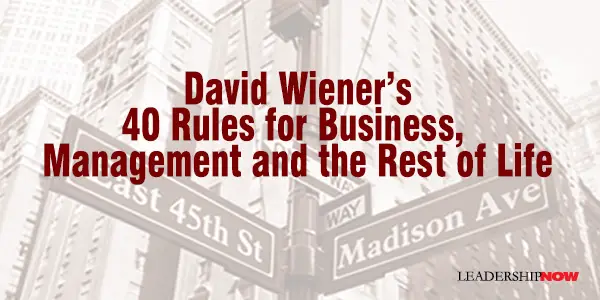
I As I have matured and learned more about both business and life, I have become less economically fearful and defensive. This has made compliance with my no-jerk rule quite a bit easier. Fools, I’ve come to realize, thrive on our defensiveness, fears, and insecurities. Those qualities are to idiots what peanut butter on turkey is to rats. Know yourself and respect your own needs, and the jerks will not be able to enter your premises. Got it? Good. Now make it happen. I am approaching my fiftieth year in business. Whew! Thinking back on the lessons I learned when I was wet behind the ears, it strikes me that the technologies, financial methodologies, and expectation levels when I cashed my first paycheck were profoundly different than today. Meanwhile, the underlying interpersonal dynamics—the methods of creating and managing relationships—are fundamentally unchanged. The goal in business is to bring in more money than you spend over the long run. To do that, you need to obtain the cooperation, support, and goodwill of many people. I’m generally not sentimental; I don’t think making money was necessarily easier in the old days or that people were intrinsically nicer, more honest, or more loyal—it’s probably easier to turn a buck today than it was in earlier times. Preparation is easier today. You can learn more about the people you want to do business with by spending an hour on the internet than you could in a week making phone calls or buttonholing people. Few people become successful entirely on their own. Most successful business people are highly successful managers. The following are some of the core beliefs that have guided me in assembling, motivating, and keeping my team intact:
 
Posted by Michael McKinney at 09:18 AM
06.06.18

Beyond the Drama Triangle
Y This triangle was developed as a social model years ago by Stephen Karpman, a student of Dr. Eric Berne, the father of Transactional Analysis. It maps out a type of dysfunctional interaction that is common in the workplace and in our homes as well. The word “dysfunctional” is nothing to be afraid of – it just means “not working very well.” Effective leaders notice when their relationships are working and when they aren’t … and as a result, they learn to stay out of the Drama Triangle. Karpman used this triangle to define three points that arise predictably in any dysfunctional real-life drama: the Persecutor, the Victim, and the Rescuer. Notice that all three of these are roles we can choose to play, or choose to step back from, at any time. So for instance, let’s assume that one of your team members promised you an update about an important project by Tuesday afternoon. It’s Wednesday morning. You don’t have the report yet. Here are three ways you could choose to respond:
Every time you see one of these roles emerge, or find yourself tempted to play one of them, you can be certain that the Drama Triangle is beckoning … and you’re about to get sucked into it. One classic pattern is: boss attacks (Persecutor), people defend themselves (Victim), other people come to their aid (Rescuer). Be honest. How often do you really want to do that? Here’s what’s important to notice: The Drama Triangle is a game. If you choose to play, you’ll be asking for an exchange that’s high on conflict and denial, and low on resourcefulness, self-awareness, and win/win outcomes. The problem is, it’s easy to play this game without even realizing that you’re playing and easy to become addicted to drama without realizing you’re addicted to it. A lot of the leaders we work with are shocked to learn that most of their workplace interactions fall within this dysfunctional triangle! The leader’s title typically means he or she is given the responsibility of judging or dictating … and that can be a slippery slope toward the Persecutor role. If you’re not careful, you can spend the majority of their working hours playing this game. It doesn’t have to be that way. The very first step to overcoming a drama addiction is simply to learn to recognize what’s happening. Start noticing that the Drama Triangle game typically begins with one person – it could be you – taking up the Persecutor or Victim role. If you sense a piece of communication coming from your side that is some variation on “It’s all your fault” or “Poor me,” step back, take a deep breath, and ask yourself if that’s really the only way you can express yourself. It’s possible you’ll come up with a better way of approaching the situation – one that doesn’t simply invite the other person to intensify the drama. For instance:
No blame. No drama. Just good communication! Your responsibility as a leader is to support your people, start good conversations, and make good outcomes possible. The Drama Triangle goes in the exact opposite direction of all three of those goals: it disempowers your team, starts lousy conversations, and makes terrible outcomes much more likely. If you spend even one minute a day in the Drama Triangle, that’s one minute too much. The only way to win this particular game to resolve not to play – and then stick with that decision!   Editor’s Note: The Road To Excellence asks the question, “What, exactly, stands between my company and organizational excellence—and what do I do about it?” David Mattson identifies 14 blind spots that have the potential to kill a business. The problem, of course, is seeing what you don’t know. The Excellence Process consists of six steps that when taken in order and made part of your culture will turn excellence into a process and help to get rid of your blind spots. Editor’s Note: The Road To Excellence asks the question, “What, exactly, stands between my company and organizational excellence—and what do I do about it?” David Mattson identifies 14 blind spots that have the potential to kill a business. The problem, of course, is seeing what you don’t know. The Excellence Process consists of six steps that when taken in order and made part of your culture will turn excellence into a process and help to get rid of your blind spots.

Posted by Michael McKinney at 09:03 AM
02.24.17

Asking the Right Questions Often Leads to the Best Answer
BEING A LEADER often means making far-reaching decisions that require major investments of time, resources, and energy. Complete certainty is seldom possible. Competing agendas often complicate the process. The future is never something you can take for granted. So you need to be as dispassionate as possible in how you examine opportunities and vulnerabilities. Knowing how to ask the right questions is essential to sorting through the options, clarifying objectives and making the best decision possible. Good leaders are adept at asking strategic questions. These are the types of questions that deepen understanding and look over the horizon. By asking more of these questions – of yourself and others -- you articulate goals, set benchmarks and assess risk. You become a better thinker and a smarter leader. Strategic questions zoom out and look at the big picture. They ask about long-term goals, interests, and priorities. They consider alternatives, consequences, and downsides. They sharpen the focus on the larger objective and clarify what it will take to get there. Strategic questions break into distinct categories. Big Question: Cost and Consequence: Trade-offs: Alternatives: Define Success: Listen: Try: CEOs are often the most successful people. Many of them possess a hidden skill – the ability to ask questions that help envision the future, assess risk and reward, and anticipate trends.  
Posted by Michael McKinney at 07:25 AM
04.25.16

Making Sense of Speed, Agility and Innovation Every executive knows that speed is important. Meg Whitman at Hewlett-Packard declared recently that “the future belongs to the fast.” But is speed enough? If you can simply accelerate the current activities, products and strategies that your business implements, will that help you win in the future? Or what about being more “agile.” Agile was originally a software technique, meant to shorten software development times and make the development team more accountable to customer needs. From there, everyone is adopting the concept of “agile.” There’s agile marketing, introduced by thought leaders at CMG. Can agile help you win more? Of course. Is it, by itself, enough? Probably not. Or, think about innovation. There’s probably no other topic that has the same level of emphasis across industries and geographies. Everyone knows innovation is important. But again, if you can innovate successfully, is that enough? Do any of these factors, by themselves, help your company win? We believe that each of these factors is important, but left to themselves, implemented in a discrete fashion, without integration or coordination they won’t make a significant difference. But if you could create a framework in which each of these activities were a vital component leading to a completely new way to compete, then you’d see a significant impact on your revenues, profits and market share. Maneuver Strategy Fortunately, such an integrated framework exists. In our book OutManeuver we detail a new competitive strategy that leverages speed, agility, insight and innovation to win the most at the least possible cost. Maneuver stands in opposition to existing “attrition” strategy, where firms fight expensive battles over small differences in market share based on essentially similar products. Feature to feature competition fought over a fixed market leads to commoditization and price wars, ignoring differentiators like speed, agility and innovation that may open new markets or create new alternatives. Maneuver, like attrition, is a military strategy that has been adapted to business competition, yet to date attrition has been the predominant business strategy. That’s because attrition requires less planning and less insight, and is often easier to implement initially, because it simply copies what competitors are doing and seeks to damage or destroy competitors. Maneuver, on the other hand, seeks to identify and win valuable but unoccupied markets, segments or channels, or, if attacking a competitor is required, discovering vulnerabilities that can be exploited at the least possible cost. Thus, while attrition requires little upfront thinking, it has a high cost of implementation, while maneuver requires more reconnaissance and intelligence and has a lower cost of execution. The “what” and the “why” In truth, factors like speed, agility and innovation aren’t all that valuable by themselves. They are enablers to a larger capability – maneuver strategy. Many corporations are focusing on the “how” – more speed, more agility and more innovation, without thinking about the “why.” Speed, agility and innovation aren’t required in an attrition strategy, but are definitely important in a maneuver strategy. But without the appropriate strategy, speed, agility and innovation may not pay off. OutManeuver develops the importance and applicability of maneuver strategy, and demonstrates how to use enablers like speed, agility, insight and innovation to win more at the least possible cost. So, the next time someone tells you that the “future belongs to the fast,” or that you must increase your innovation output, ask them about their strategy. If your corporate strategy is based on attrition, there’s little need for more speed or innovation, because attrition is an expensive but broad based battle against incumbents. Instead, you could assist with a rethinking of strategy, to introduce maneuver strategy and tactics, which will leverage speed, agility and innovation and reinforce new strategic thinking, to win more at less cost. Jeffrey Phillips and Alex Verjovsky are the authors of Outmaneuver: OutThink, don’t OutSpend. Phillips leads OVO Innovation, an innovation consulting company in Raleigh, NC. Verjovsky is a consultant, an entrepreneur, and a pioneer in the biodiesel market. 
Posted by Michael McKinney at 11:58 PM
09.04.15

Missing Ingredients: Finding the Right Team Recipe
IN my 25 years of professional endeavors, the lessons I apply the most often…the tools I use to achieve success . . . the skills I call on every day . . . all of these things I experienced and developed to one degree or another through sports. And when the discussion is about team sports, coaching, leadership, chemistry, relationships, role players, and all-stars become a natural part of the conversation. I find that the same is true in my business experiences and my work with civic organizations, where the natural question is why some teams perform better than others, and how to improve the performance of those that are struggling. There are a number of ways to look at this challenge, but to me, it usually comes down to three important things:1. Same Page of the Playbook: There are many reasons why a team may be struggling, but the first place to look is the source of any activity: everyone has to agree on the foundation before you put up the house. This is true in business, true in civics, and true in life. In my new book Xbox Revisited, I chronicle the challenges we faced during the formation of the Xbox business. The cold, hard truth is that we failed to establish a strategic foundation for the business, and as a result, the team was dysfunctional, our execution was inconsistent, and the business lost north of $5 billion over 4 years. We subsequently backfilled that mistake with a 3-page document that defined the Purpose, Principles, and Priorities for our second product, Xbox 360. This 3P Framework strategy process is chronicled in Xbox Revisited, and I now use it in my consulting, board work, and civic engagements. It forced the Xbox team to define a single Purpose, a joint set of operating Principles, and a focused list of Priorities that we used consistently to drive the business to market share leadership and substantial profitability for Microsoft. 2. Managers, Coaches, and Captains: Even with the greatest strategy, teams can still flounder without the right leadership. In fact, many of our early struggles on Xbox were a function of my leadership as Chief Xbox Officer – although I had many of the right instincts, I was simply too inexperienced to deal with the type and level of issues we faced on Xbox. Great leaders have to be self-aware of their own strengths (what I call super-powers) and weaknesses (kryptonite) and build a team around them that fills in identified gaps. The next level of leadership has to understand their roles and responsibilities well and translate that down through the team, consistent with the strategy framework that is driving the business. Just as with any sports team, there is no "correct" structure for a group – but everyone must know, accept, and perform their roles effectively if the team hopes to be successful. Great leaders identify weak team members or those that have not bought into the strategy/their role and either help them improve quickly or replace them. This is difficult work – both because it takes great judgment to know when to "hold 'em" and when to "fold 'em", and because the process of firing and replacing someone is emotionally challenging if you are a caring manager. And yet, the fact remains that there is quite often "addition by subtraction" and no team is much better than its weakest link. 3. Executing the Game Plan: A strong strategy framework with good team leadership is enough to get you to the starting line – but game-time performance is entirely a different matter. There are many teams that look good on paper but can't actually perform to expectations. Great communication is certainly a central element in establishing an operating rhythm that drives day-to-day excellence because once the game begins, modifications and adjustments are a constant requirement. This is the football equivalent of an audible called by the quarterback at the line of scrimmage. If everyone on the field doesn't hear that the play has changed, the whole effort falls apart. Great execution is also about efficient and effective decision-making up and down the ladder of the team. If decisions can be pushed down into the organization where people closest to the issues can make the quickest and best decisions, the team has a much higher likelihood of success. In contrast, if everything must flow up the chain and back down again, as it often did in our early Xbox days, the likely result is either poor, uninformed choices or decision constipation. Finally, winning on the field is about continuous improvement. Teams that struggle at first can ultimately be successful if they keep making mid-course adjustments – changes in people, process, decisions, etc. Most projects are marathons not sprints and the secret to success is finishing strong and fast. This sporting analogy and the discussion of teams applies across a broad cross-section of organizations. The dynamics and culture of a business are certainly different than what you might find in a government agency, a community organization, or a non-profit. But the elements that make a great team and create an environment for success are similar in all of these cases. So whether your goal is renewing your business or joining me as a Civic Engineer trying to improve our local, state, and national civic organizations, building the right team is a critical element to success.  
Posted by Michael McKinney at 04:44 PM
07.28.14

8 Shifts Young Leaders Need to Make
I WAS STANDING in a hotel lobby waiting on my buddy to get some coffee before we were headed out for a day at a conference we were working. I was standing against the wall with my computer bag on my back. We were running a little late, so on the spur of the moment, I decided I'd go get the rental car and bring it to the lobby's front door. As I stepped away from the wall, I had no idea the pandemonium that would ensue. Apparently my bag had gotten caught on the fire alarm in the hotel lobby. In an odd case of events, when I stepped away from the wall, the fire alarm went off and people began to scatter. The hotel lobby that was rather full of folks eating breakfast and enjoying their morning coffee suddenly began to empty as people began to look around and evacuate the lobby. You see, that's what happens when alarms go off, people move. For the next generation, an alarm of sorts is going off. An alarm that, if ignored or simply silenced, will continue to get louder and louder. An alarm that, if left unanswered, could mean serious trouble for the next generation and our world as we know it. Poverty rates have never been higher, unemployment rates are astronomically high, and people are hurting all over our world. Children are being abandoned by parents that have other priorities and people are willing to kill over hearsay and gossip. Our culture is in need of young leaders that are willing to not just silence the alarm with quick fixes but sustain lasting change in the world we live in. We need young leaders that can rally people around them and begin bringing people together for lasting change. How can we answer the alarm? By making some shifts in our lives and in our leadership in order to help lead lasting change in our society. Here are 8 shifts that we need to make as young people in order to set ourselves up to lead well now and in the future. From Entitlement to Honor From Unreliable to Consistent From Dissension to Cooperation From Conformity to Integrity From Pride to Humility From Passive to Passionate From Selfishness to Love From Premature to Patient We can make the shifts as a generation. We can answer the alarm and change the world for our kids and their kids. The question is, "Are you willing?"  
Posted by Michael McKinney at 06:58 AM
12.16.13

Are You a Thought Leader?
WHAT IS a thought leader, and what does thought leadership mean in today’s business world? As much as some people wish it wasn’t so, a thought leader is not someone who simply restates someone else’s views and positions. Furthermore, beyond uniqueness of thought, a true thought leader’s positions also challenge established norms and conventions. Moreover, the true litmus test for a thought leader is when their unique ideas are implemented in the marketplace, they tend to create disruptive innovation, and often change the way we view the world. It is certainly much easier to look back in time at world leaders, Nobel laureates, religious scholars, philosophers, and captains of industry to identify historical thought leaders than it is to identify today’s visionaries. This is due to the fact that thought leadership was once a term reserved for a limited few. Regrettably, the label of thought leader has evolved to become a self-bestowed title for anyone who has something to say or promote, often without regard for qualitative issues. Some would say that the term thought leader, once synonymous with futurist and innovator, is more closely aligned with snake-oil salesman today. Don’t get me wrong, true thought leaders still exist; they are just much harder to spot these days. Let me begin by stating that authentic thought leaders, the real deals, are not created via great marketing and PR alone. While they are oft published, quite outspoken, and many times represented by marvelous publicists, they are not merely contrived, self-promoted legends in their own minds. Rather true thought leaders are born out of real-world successes, achievements, and contributions that have been recognized by their peers and competitors alike. Their work is widely regarded as being innovative, disruptive, and market altering. They are not the posers, but the players. They are not spin masters trying to make it, but are the undisputed market leaders that have already arrived. It is also important to draw a distinction between personal or corporate branding and thought leadership. While thought leaders often become well-recognized brands, there are many well-crafted brands that have messaged thought leadership where none exists. Don’t allow yourself to get caught up in the spin and hype associated with great marketers who will gladly accept compensation, but will leave you woefully disappointed when it comes to living up to their billing. Look for real results based upon market leadership, and not just brand leadership alone. I have nothing against the term thought leader, however, it is my opinion the label should be reserved as an honor to bestow upon a select few, and not a title to be adopted by the masses. Dilution has the opposite effect of scarcity in that it diminishes value. Bottom line…judge people on their actions and results, not their rhetoric or their title. Don’t accept conventional wisdom as gospel unless you can validate proof of concept, and then only accept it if you can innovate with it, or around it. Challenge everything in business by looking to improve upon the status quo and differentiate yourself from your competition. I don’t advise my clients to adopt the practices of their peers, but rather to be disruptive with their innovation such that they create or widen market gaps between themselves and their peers. Lastly, when you run across a real thought leader, you’ll clearly recognize them as such for there is something truly unique in both their words and deeds.  
Posted by Michael McKinney at 05:22 PM
09.23.13

8 Ways to Have a Successful Partnership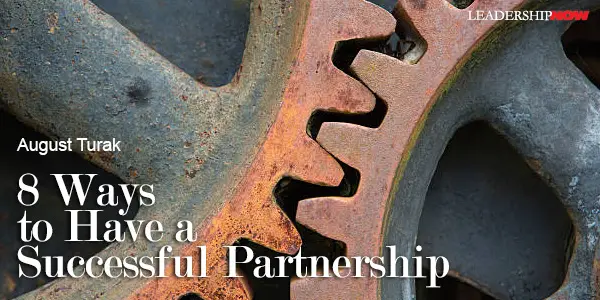
I N A MARKETPLACE gone global, productive partnerships are more crucial than ever. Partnering has become so critical that the word "coopetition" had to be coined to describe companies that partner in some areas while competing in others. Yet very few partnerships ever deliver on their symbiotic promise. Why? The single biggest mistake we make in our partnership efforts is treating potential partners as if they were end users. While the interests of partners and end-users must overlap they are seldom if ever identical. Through many years of business experience, I learned some great lessons on what it takes to produce a successful partnership.
 
Posted by Michael McKinney at 10:41 PM
03.07.13

Predictive Analytics: Making Data Valuable
THOMAS DAVENPORT says that we live in a predictive society. Black Swans notwithstanding, most human behavior is quite regular and predictable. It perhaps goes without saying that organizations secure a competitive stronghold by predicting the future destiny and value of individual assets. Prediction though, is easier said than done. It involves a complex mix of data, all weighed in varying degrees. However, predictions need not be “accurate” to score big value, says Eric Siegel in Predictive Analytics. For example: One of the most straightforward commercial applications of predictive technology is deciding whom to target when a company sends direct mail. If the learning process identifies a carefully defined group of customers who are predicted to be, say, three time more likely than average to respond positively to the mail, the company profits big time by preemptively removing nonresponders from the mailing list. And those nonresponders in turn benefit, contending with less junk mail. Data, while often considered eminently boring, “embodies a priceless collection of experience from which to learn.” It’s a way to leverage what you know—where you’ve been. This mind-numbing work can be done—and is done—almost automatically by computer. With computers we are able to discover new patterns and develop new knowledge by processing huge amounts of data—almost automatically. “Machine learning,” as it is called, “develops predictive capabilities with a form of number-crunching, a trial-and-error learning process that builds upon statistics and computer science.” Interestingly, Siegel writes, “the machine actually leans more about your next likely action by studying others than by studying you.” Prediction empowers the organization with an entirely new form of competitive armament. “Predictive Analytics is the process by which an organization learns from the experience it has collectively gained across its team members and computer systems. In fact, an organization that doesn’t leverage its data in this way is like a person with a photographic memory who never bothers to think.” “Predictions drive how organizations treat and serve an individual, across the operations that define a functional society.” How can we use this emerging science to use data-driven predictions to improve the effectiveness of business and the quality of our lives?   
Posted by Michael McKinney at 11:53 PM
02.20.13

Into the Storm: Lessons in Teamwork from the Treacherous Sydney to Hobart Ocean Race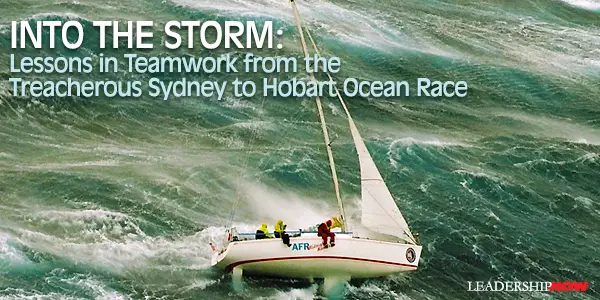
The iconic Sydney to Hobart Race, a 723-mile deepwater challenge—often called the "Everest" of offshore ocean racing—is considered one of the toughest in the world. Unpredictable weather and seas make each race demanding, but in 1998, an unexpected "weather bomb" hit the fleet, creating 80-foot waves and 100-mile-per-hour winds. Many bigger, better-equipped boats tried to maneuver around the storm, but the crew of the AFR Midnight Rambler chose to head directly into its path. After battling mountainous waves and hurricane-force winds in the Bass Strait, the tiny 35-foot boat arrived safely in Hobart, 3 days and 16 hours later—winning the coveted Tattersall’s Cup. THERE are two central themes in Into the Storm. The first is the importance of exceptional teamwork in overcoming challenges at The Edge. The second is the value of distributed leadership—a team culture that allows every person to provide direction when he or she has expertise that will help the team succeed. The story of the AFR Midnight Rambler exemplifies the power of exceptional teamwork and distributed leadership. But where does this leave a formal team leader—the skipper of a boat, the CEO of a corporation, the commanding officer of a military unit, or the President of the United States, for that matter? Is there a unique role that he or she needs to play? I believe there are some critical things—some unique responsibilities—that fall to the skipper. The leader needs to keep the team aligned. The varied performance of boats in the Sydney to Hobart Race underscores the importance of having a coherent, unified team. Some boats, like the Midnight Rambler, demonstrated extraordinary cohesiveness even under the most terrifying, life-threatening conditions. At the other end of the alignment continuum, some crews were fragmented, with key team members at odds with each other—in a leadership vacuum. Adrienne Cahalan, one of the world's best navigators, has had a chance to observe the role of the leader in more than twenty-five years as a professional competitive sailor. She has been named Australian Yachtswoman of the Year twice—and has been nominated four times for World Yachtswoman of the Year. Cahalan characterized the leader's role this way: "Skippers need to keep the team focused. They need to keep an eye out to see if someone is wavering, or a faction developing. They need to have the skill to manage all the personalities, to bring them together, and to get them working toward their common goal. Not everybody's perfect, so a good leader is able to deal with imperfections. And they need to be able to do it all under pressure." Managing personalities and bringing people together can be challenging in any situation. But the pressure of a storm—or a tough business obstacle—calls for exceptional leadership. The leader needs to demonstrate passion. The leader's passion is a magnetic force that pulls other people in. Describing the impact of Ed's enthusiasm, one crewmember observed: "What makes Ed an exceptional leader is his desire to win. He is committed to driving the boat as fast as it can go. And he can take risks because of his comfort and trust in the team." No one who has ever sailed with Ed Psaltis has any doubt about his absolute, total commitment to winning. He is so passionate that his excitement sometimes needs to be offset -- by humor, or by the composure of others. But there is no mistaking the electric spark that comes from a leader who is excited to win. That enthusiasm is contagious, and it is a contagion that leads to victory. The leader needs to instill optimism and confidence that the team will succeed. Ed Psaltis and navigator Bob Thomas have a close relationship. They have complementary personalities, with Bob's cool demeanor balancing Ed's passion. Both Ed and Bob joined forces during the storm, and their combined leadership provided a reassuring presence for the crew. Crew member "Mix" Bencsik recalls: "Their leadership played a large part in making sure that no one gave up. Ed and Bob constantly instilled optimism and confidence that we could handle the conditions, and that the crew had the ability to win." While there was no question about Ed's formal role as skipper, Ed and Bob together reinforced a sense of unified leadership. And because of their close personal relationship, they were able to send a joint message of reassurance and optimism. The leader needs to set an example. Ed realizes that people are watching him, and he makes a conscious effort to set an example. Coming off his watch as helmsman, Ed will take a forward position on the rail. In this exposed position, he is subjected to the first onslaught of water and spray. It is cold and uncomfortable, but it is clear that Ed is not afraid to do his share. Ed will also take his turn in "the bad bunk." It seems that every boat comes equipped with a berth that—for one reason or another—is undesirable. Nobody wants the bad bunk, but Ed makes sure that he takes his turn. He is sending a message. Leaders need to set an example on a daily basis, but there are some moments that are different. There are times when leaders need to inspire others through fortitude, courage, and skill. One such moment came for Ed Psaltis in the 1998 Sydney to Hobart Race. Mix Bencsik reflected: "I've been through a lot of storms with Ed. Sitting on the side of the boat—wave spotting while he was helming -- was something that made me feel really proud. I thought, Here's a person who has my life completely in his hands. He was performing extraordinary feats of strength and seamanship, holding a 35-foot boat on the right course in those conditions." "Ed was giving more than 110 percent. The well-being of the boat and crew were in his hands, and he didn't falter. It was an outstanding feat of seamanship. Even to this day, it's quite emotional to talk about. That was his finest moment." Not every leader has the ability to steer a boat through a storm like Ed Psaltis. But there comes a time when every leader needs to be willing to step up and give "more than 110 percent." For every leader, there can be a finest moment.  
Posted by Michael McKinney at 10:44 PM
01.17.13

At Work, "Yes" is Great, but at Times "No" is Even Better At work, we want our jobs, assignments, projects and "stuff" to move along smoothly: achieving objectives, getting promoted, winning contracts. It's almost a twitch reflex to want our jobs to behave themselves. And if we are honest, sometimes we may even secretly wish that the workplace could deliver a continuous, uninterrupted "yes"—"yes" I got the plum job; "yes" the budget was approved; "yes" the redesign has been accepted. And not only do we want "yes" from our jobs, we also want to deliver "yes" in return - especially when results are expected: "yes" we can deliver doubled digit growth; "yes" we'll exceed the deadline and come in under budget; "yes" we can close the deal. But, as we all know, work doesn't behave this way. It's far too unruly: deadlines are too tight, salary increases are too small, business deals wither. And often instead of saying hello to "Yes", we find "No" at the front of the line offering personnel conflicts, career disappointments and project derailments. But rather than treating "no" as an annoying intruder on our journey to "yes", maybe we could take a different approach—maybe "no" isn't such a bad guy after all—maybe "no" is exactly what we've been looking for. And here are three reasons why. Emphasizing "yes" can dull our edge When we impulsively look for "yes" from our subordinates, colleagues, vendors and others, we tend to emphasize harmony over clarity; convenience over excellence; perception over results. Such seeming harmony can dull a team's creative edge and mask issues that need our attention. Are we emotionally confident enough to hear the facts rather than a "managed narrative"? Do we rush past problems in order to get to a solution or can we linger and explore difficulties thoroughly? Do we invite "no" from others when we sense that it is being held back? When we appreciate the importance of "no", convenience becomes irrelevant, our intelligent "edge" is permitted to clarify problems and getting a realistic picture takes priority. Avoiding "no" represses candor and causes team problems It is typical for team members to test boundaries and try to form reliable relationships and inevitably, such testing creates friction where individuals say "no" to certain group demands and limits. We all know what this looks like: Why does Sally get to lead this effort, why not me? Those budget estimates are way too low, but no one listens to me. I authored the sales plan, why can't I present it? When we are uncomfortable with the emotions accompanying such conflict, we may tend to avoid the required candor, hurrying toward a false "yes" of familiar routines and politeness. When teams choose avoidance over candor, we can end up repressing feelings that later arise as simmering frustrations or at times active resistance. Too often, by avoiding "no" we disguise problems rather than solve them. "No" creates much needed psychological space Finally, when we are constantly chasing "yes" -- trying to become smarter, faster, cheaper, and more profitable -- we can at times speed past the very things that need our attention. Such speed to succeed can blind us, but "no" can slow us down and offer some psychological space: Can we describe the top three difficulties our customers are having with the new release 4.0? What is the employment turnover with our key sales folks and should it be lower? What are the three main motivators for our medical affairs physicians and are we focusing in on them? These and hundreds of other similar business questions require us to slow down in our relentless pursuit of "yes" and consider "no" as an ally. And when we make friends with "no", we discover psychological space and time to reflect, not just on where we are going but, as importantly, on how we are getting there. So, in the end work is very much about "yes" -- "yes" I can take that stretch assignment; "yes" I'll work extra hours; "yes", the project is on track. But if work is all about "yes", chances are we are avoiding some vital issues, and we may need to make friends with "no". Michael Carroll, author of Fearless at Work, worked on Wall Street and in the publishing industry for over two decades, holding executive positions at Shearson Lehman Brothers, Paine Webber, Simon & Schuster, and the Walt Disney Company. Founding director of AAW Associates, Carroll consults with major corporations on bringing mindfulness into the workplace. He is a longtime student of Buddhist meditation and an authorized teacher in the lineage of Chögyam Trungpa. Carroll has taught mindfulness meditation at the Wharton School of Business, Columbia University, Kripalu, and the Cape Cod Institute. For more information please visit http://www.awakeatwork.net, and follow the author on Facebook and Twitter. 
Posted by Michael McKinney at 09:25 PM
10.11.12

Rebel Entrepreneurs Avoid Conventional Wisdom There is a dirty little secret that most famous entrepreneurs and those that back the start-up culture prefer not to tell you—success in business is a minority sport. In most developed countries, the overwhelming majority of all privately held enterprises are small – about 95 per cent, according to the OECD, the economic body that measures such things. The vast majority of these are sole traders. There is also an incredibly high failure fate among new ventures. About 8 out of every 10 of the companies started each year do not make it to their fifth birthday. Only a small percentage of those businesses that manage to struggle on beyond infancy then go on to create the real growth drivers of an economy. However, it is these companies that are so important to the success of economies, providing new products and services as well as improvements in productivity that raise the standards of living of a society, and, perhaps most importantly, the lion’s share of new private sector jobs. Just 7 per cent of businesses are responsible for more than half the new employment created in the UK economy, the British think tank Nesta recently calculated. This figure is about the same across developed nations, according to the OECD. Nesta went further than this in its analysis, however, concluding that the job creation is actually only happening among very young fast-growing companies. Successful entrepreneurship, it seems, is a very exclusive club indeed. What is it that sets these companies apart? One way to define them and their leadership is as rule breakers. That is what my book, The Rebel Entrepreneur, is all about. I am not saying that founders can only succeed by engaging in illegal behaviour. Sadly, there have been too many examples of this in recent years, but these people are criminals not wealth creators. No, the true rebel entrepreneur knows that the best way to get ahead is to avoid being sucked in by conventional wisdom. Take pricing strategies, for instance. In hard times, conventional wisdom may say cut your prices to preserve customer numbers and therefore sales. However, as many successful companies have shown, the best policy is often to raise your prices. Look at Apple, the world’s most successful technology business, which insists on raising the prices of its products even as the western world struggles to recover from recession. Does this put off the customers? Not a bit of it. In fact, the high price appears to act as a guarantee of quality. More than this, by maintaining the high price, Apple is able to continue to increase revenue and profit even if sales dip. Rebel entrepreneurship can be found in most areas of business building if you are prepared to look. Just be prepared to resist following the crowd. Jonathan Moules is the Enterprise Editor for The Financial Times, where he has profiled hundreds of companies and their owners. He has written extensively on successful entrepreneurs. Moules spent 5 years in the FT's New York office, where he held numerous positions, including technology, media and telecoms news editor. He wrote specifically about the US mobile phone industry and new media businesses, and he covered the dotcom bubble and its aftermath. 
Posted by Michael McKinney at 07:09 PM
08.21.12

The Main Thing: How to Keep Organizations Centered on What Matters Most "The main thing is to keep the Main Thing the main thing!" We loved that expression when we first heard it from Jim Barksdale, then the COO of FedEx. That single sentence captures the greatest challenge that executives and managers face today: keeping their people and their organizations centered on what matters most. Every organization needs a Main Thing—a single, powerful expression of what it hopes to accomplish. Without it, it's not possible to align the four elements that produce organizational efficiency and effectiveness: strategy, people, customers, and processes. Does your organization have a Main Thing? Do your people understand it? Are they guided by it? Fred Smith, the Founder and CEO of FedEx, once described to us his understanding of The Main Thing—which he refers to as the "theory of the business." Every successful business has, at its heart, a theory of the business—an underlying set of supporting objectives and a corporate philosophy that gives people a foundation on which to operate. Working inside that framework, they've got an idea of what we want them to do—to prioritize. We [at FedEx] have a very clear business mission and a business theory which is understood certainly by every member of the management team, and probably by 90 percent of the work force."The Main Thing is critically important. It is the end that strategy and human effort serve. We cannot achieve and maintain alignment without consensus and conviction about The Main Thing. Yet we are always amazed by how few people can articulate their organization's main thing. When we ask participants in workshops, "What's your Main Thing?" we see people digging into their wallets for the latest mission statement. Others look questioningly to the person sitting next to them. We wonder how these people can formulate a strategy or know how well they are doing if they cannot even state—or agree on—the ultimate purpose of their work. Some people, however, can articulate their Main Thing without hesitation. Here are a few examples:
What is The Main Thing for your organization? Can you articulate it clearly and concisely? Can your subordinates? In many organizations, people have no clear answer, or will offer a confusing list of lofty goals. Others will describe their strategy. But a strategy is not The Main Thing; it is merely its servant. In some cases senior management defines The Main Thing one way and the people in the trenches define it in another. In these cases people and policies work at cross-purpose; one person is pulling when the other guy is pushing. As you formulate a Main Thing for your organization, keep these guidelines in mind:
Dr. George H. Labovitz is the founder and CEO of ODI, an international management training and consulting company, and professor of management and organizational behavior at the Boston University Graduate School of Management. Victor Rosansky is co-founder and president of LHR International, Inc. He has more than 25 years of experience as a consultant, helping Fortune 500 clients to drive rapid strategy deployment and alignment. 
Posted by Michael McKinney at 02:39 PM
04.23.12

Why Leaders Can NOT Procrastinate You're about to end a conference call, and someone says, "Great, we'll send you some materials right away." A day goes by, and then a week. What happens to your confidence in that person? Surely, you may continue to do business together, but you'll always wonder if they'll do what they said they'd do, in the time they promised. So, now is the time to look in the mirror Are you putting something off? Because you forgot, or is it on purpose? Are you missing key resources? Are you waiting for key data before you can make the next decision? Or, are you procrastinating? Begin by exploring your own daily routines. When you understand HOW you work, you can get things done more effectively. Here's an activity you can experiment with this week. Write down the approximate time you arrive and leave the office every day. This represents your “work-week.” (I call this the "window of professional productivity.") For each single hour you were working, you made choices about what to focus on as “priority.” You also chose what did not get done! Here are three ways to get going and sustain an action-orientation to your own productivity:
Jason W. Womack, M.A., M. Ed., advises corporate boards and entrepreneurs on the topics of maximizing productivity and achieving a balanced lifestyle. Visit his website at www.womackcompany.com and share your questions and comments via twitter @JasonWomack.
Posted by Michael McKinney at 01:51 PM
01.09.12

What if Everything is Perfect? As a leader and someone that your team looks to for guidance and advice, has the question occurred to you… What if everything is perfect? What if everything that happens, everything that has happened, and everything that will happen is exactly what had to happen, is happening and needs to happen for your benefit and the benefit of your organization. Now I’m not asking you to take this on as “the truth,” even though it might be. I’m asking you to take this on for your benefit, as something that will empower you as you move forward in your position as a leader in your organization and in your life. Because to not take this on, what you don’t realize is that you turn yourself into a victim. And I must say that being a victim is a very popular game. Don’t take responsibility; it’s always something or someone else doing it to you. It’s never your fault. You’re just this helpless weather vane in the wind of life. Sound familiar? Here’s why it’s empowering to act as if everything is perfect: because then you will learn and grow from the experiences of life and constantly become more of who you could be. And, I assert, becoming more of who you could be is exactly what you want to use this life for. How does this work? First you have to start from the proposition that life and business is not about winning or losing. Rather, it’s about winning or having learning experiences. So you look at everything either as a win, in which case you celebrate the win and learn how to continue winning, or as a learning experience, not a win, in which case you also learn how to do a better job next time so that you increase the likelihood of winning. Either way, you win. Here’s a common example: you have a conversation with someone and it doesn’t go very well, maybe it actually turns into an argument, maybe you leave with your feelings hurt, whatever. From the perspective of a victim, you blame the other, they blame you, you dig deeper into your position and you plan your next attack. But if you look from the perspective of perfection, you look to see what went wrong in the conversation, how come it turned into an argument, what you did to contribute to that, what you could do in the future so that things like that don’t happen again, and you even look to see that maybe you need to apologize to the other and get the conversation cleaned up. Trust me on this one and give it a try. You will discover a power within yourself that you didn’t know was there if you look at everything as perfect and take responsibility for it all. Scott Hunter has been transforming organizations for over two decades, through his innovative programs that enable people in leadership positions to master the “being” of leadership rather than the “doing” of it. His keynote speeches, workshops, retreats and management team coaching enable senior managers to shift the paradigm in which they operate so that they achieve breakthrough results and outstanding performance. Scott is the originator of the Unshackled Leadership philosophy and author of the groundbreaking book Unshackled Leadership: Building Businesses Based on Faith, Trust, Possibility and Abundance.
Posted by Michael McKinney at 10:42 PM
11.16.11

We Blame the 1%, But Still Call Them Our Leaders Approval ratings have consistently hovered at historic lows for both American political parties for years. Thousands have organized in angered protests on a near monthly basis to express their distrust and impatience with the political and economic elite, spanning stark polarities of social groups like the Occupy Wall Street movement and the Tea Party. As his own approval ratings have fallen toward the abysmal ratings of former President George W. Bush—and with the 2012 Presidential Election now looming -- the inspired election of President Obama certainly feels like ancient history. Clearly, the deep leadership problem that is wreaking havoc throughout our modern world is neither a Republican nor Democrat problem. The real problem, as I contend in my new book Lead Without Followers: How to Save Our World by Radically Redefining the Meaning of Leadership, is that we have collectively, quietly, even subconsciously lost sight of what it really means to lead—the essential, fundamental, unshakeable human core of what leadership is, amongst and on behalf of others. My book is a radical redefinition of leadership. By that, I mean to encourage you to rethink the very relation between a leader and followers. At first glance, we would all deduce that if you have no followers, you cannot lead, because you have no one to lead. A quote that I often hear attributed to John C. Maxwell goes something to the effect of, "If you think you're a leader but no one is following you, you are just a guy going for a walk." This is the highly constrained, indisputable law of today's definition of leadership. But what about what you do when you're on that walk? Do you come across others? Get presented with an opportunity to do good, do wrong, or resort to indifference? Become a hero or one of many bystanders who did nothing to help? Lend a hand? Offer a smile? Nobody lives in a bubble. In our lives, we encounter countless dozens, if not hundreds, if not thousands of lives. Each seemingly routine and mundane interaction—even with a complete stranger you'll never see again—is an opportunity to positively, negatively, or neutrally impact his or her life, potentially forever. To me, simply living in this world and among its peoples gives you the raw opportunity to become a bona fide leader. By simple choice, with some internal exploration, personal growth and everyday practice, you can become a highly influential leader that positively impacts the lives of others, every day—even without followers. I argue in my book that "leadership" has become a far too limited term that is more accurately used to define the material wealth and career success of individuals among society—those who have succeeded in acquiring high salary, prestigious job title and social status, perceived popularity and power, and masses of followers. On a subconscious level, we socially acknowledge these qualifiers of material success as indicators of an individual's supposed ability to lead. Of course, making the assumption is matter simple logic: to rise to such a level of success, one has proven his or her intelligence and abilities—important necessities for leadership on business and political levels. However, today, and especially as popular protests lambast the supposed "1%" of corrupt politicos and evil big bankers, have we quietly grown into investing far too much attention into the things that individuals have acquired—wealth, status, power, followers, etc.—to shallowly qualify them as the best potential leaders for our world? Leadership today has become a dirty word. "Politician" is even dirtier. And as public rage swirls at the simple, commonplace status quo amongst the national zeitgeist, what it means to be a leader is becoming further convoluted. If we are truly dedicated to changing what we see as wrong with our world and feel it necessary to inspire a new generation of leaders to help turn things around, we owe it to ourselves to take a good, hard, long look at how we each define leadership in its typically constrictive terms. Maybe, just maybe, if we place renewed focus and energy into defining leadership more upon what drives us to do good—passion and inspiration, love and selfless giving, vision and dedication, positivity and hope—than the socially-admired material outcomes, we'll more quickly arrive at the solution. Not everyone can lead as a CEO of a Fortune 500 company. There can only be one President of the United States. But everyone, in as little as being human, can take up the vital mantle of leadership in their every day lives based upon everything that they already have—even without followers. Dave Ursillo is a former “politico” insider turned alternative leadership writer, author and speaker. The Rhode Island native teaches men and women how to become “leaders without followers” in any walk of life by discovering a personal and profound sense of inner leadership. At 23, Ursillo abandoned his fast-tracked career path in public service amid a crisis of identity and while battling depression. Opting for the unemployment line during a 100-year recession, Ursillo has built an expansive digital platform through a growing social media presence and as an avid writer, helpful personality and determined world-changer. Ursillo’s experiences from “his past life” span five governmental offices over six years from 2003 to 2009, including the White House Council on Environmental Quality under the Bush Administration in 2008 and as a “body man” to a state gubernatorial candidate in 2009. Since its inception in 2009, DaveUrsillo.com has reached over 70,000 readers from 173 countries. In June 2011, Ursillo and his blog were also seen in a feature story on CBS Sunday Morning about the world of blogging.
Posted by Michael McKinney at 05:17 PM
11.07.11

3 Self-Limiting Mindsets that Will Hold You Back at Work
THE workplace has enough challenges and obstacles without us getting in our own way. But too often, we sabotage ourselves. Whether it’s internal forces that cause us to sell ourselves short or it’s a matter of having been conditioned not to “toot our own horn,” people have a marked tendency to avoid the limelight when in truth, they belong in it. What’s more, if you’ve always been the ‘unsung hero,’ management wants to know who you are. In my executive coaching business, I’ve worked with scores of clients over the years to help them overcome self-limiting mindsets that were holding them back in the workplace. Here are some of the most common issues:
Remember, if you don’t take credit for your own success, someone else will. That doesn’t serve your own interests. And if you think about it, it doesn’t serve the long-term interests of the company. You have a professional duty to yourself as well as your company to make sure your accomplishments are recognized and credited to you.  
Posted by Michael McKinney at 10:11 AM
|
BUILD YOUR KNOWLEDGE


How to Do Your Start-Up Right STRAIGHT TALK FOR START-UPS 
Grow Your Leadership Skills NEW AND UPCOMING LEADERSHIP BOOKS 
Leadership Minute BITE-SIZE CONCEPTS YOU CAN CHEW ON 
Classic Leadership Books BOOKS TO READ BEFORE YOU LEAD |
|